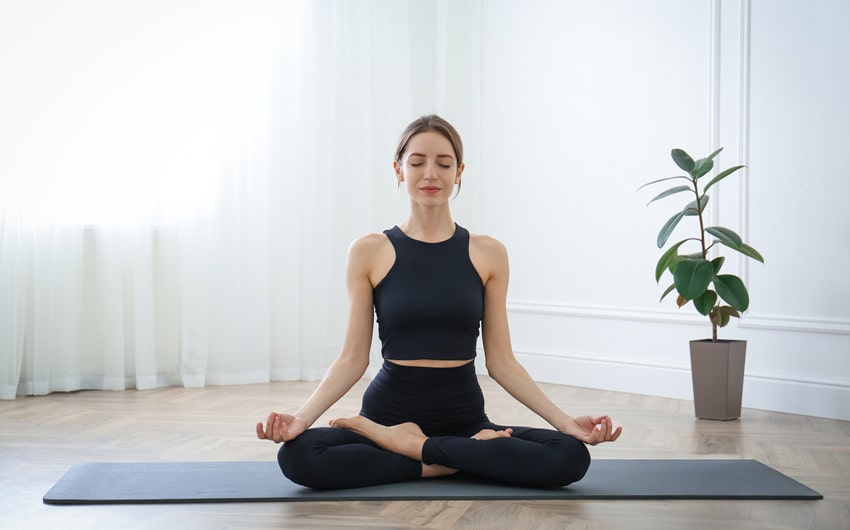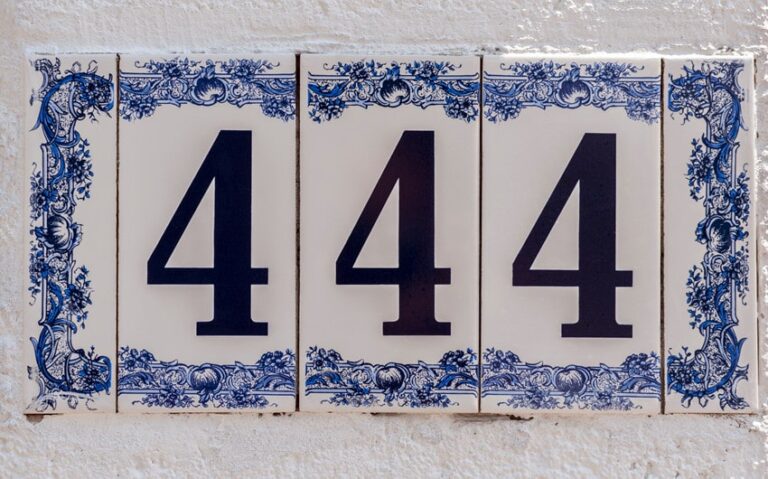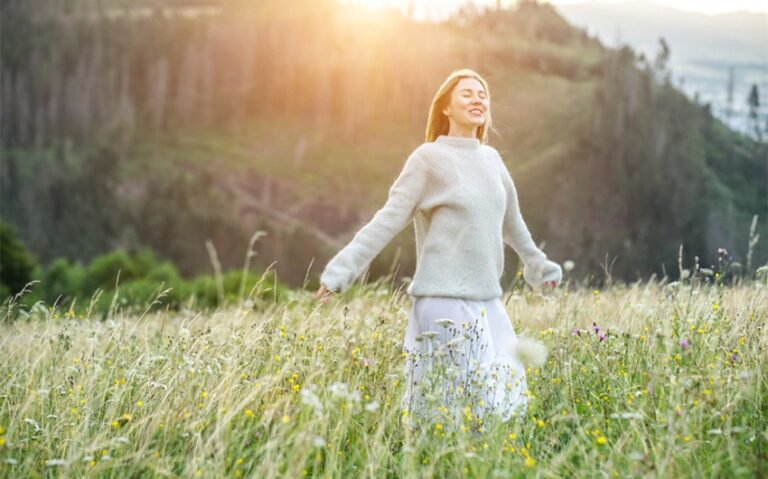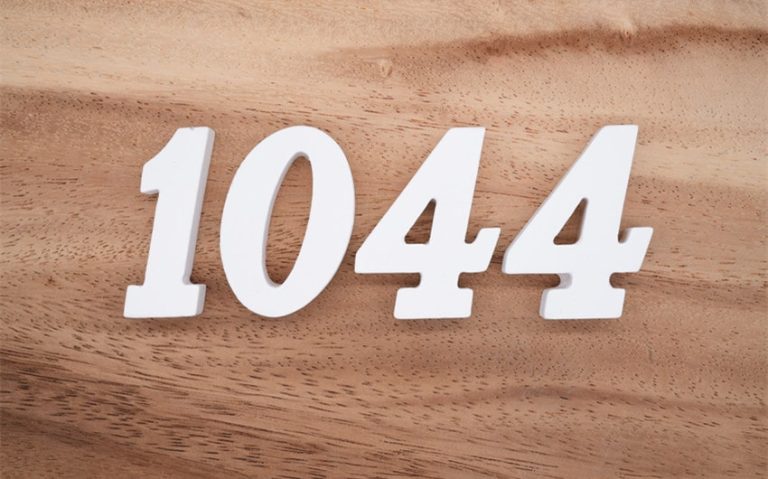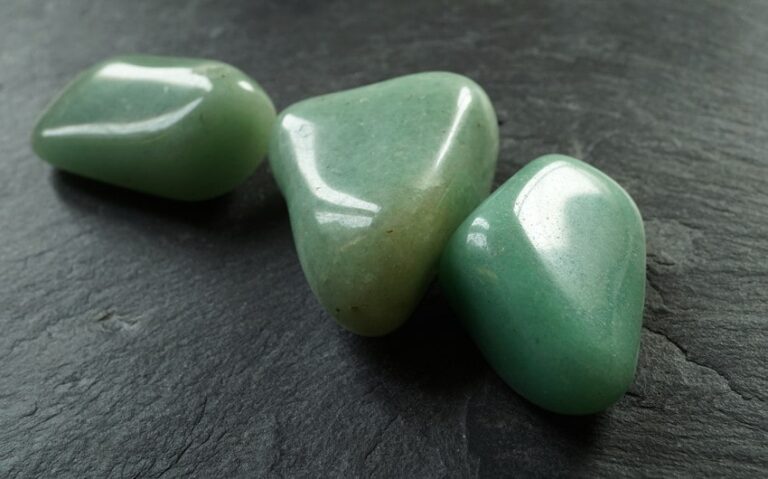55 Yoga Asana Images with Names to Start Your Yoga Journey
Yoga is more than just a workout—it’s a way to bring balance and calm into your daily life. Whether you’re a beginner or looking to refine your practice, having visual guides can make all the difference. In this article, you’ll find yoga asana images with names that are easy to follow, helping you understand the poses and their benefits.
These visuals will give you the confidence to practice at home or in class, allowing you to connect with your body while improving flexibility and strength. Let’s explore these poses and take your yoga practice to the next level!
Yoga Asanas with Images and Names
1. Tadasana (Mountain Pose)
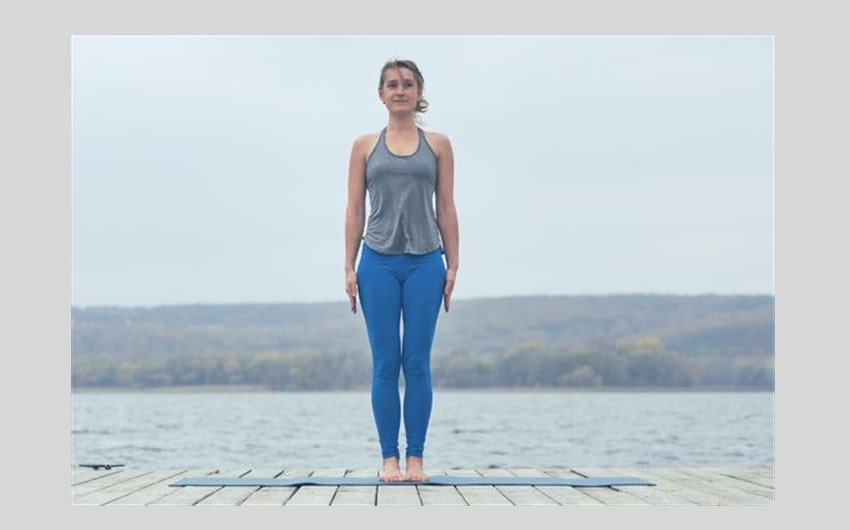
Image source: Pinterest
How to Do It: Stand tall with your feet together or slightly apart, arms relaxed by your sides. Distribute your weight evenly across both feet. Engage your thighs, lift your kneecaps, and lengthen your spine. Keep your shoulders relaxed and lift your chest slightly while pressing your feet firmly into the ground. Gaze forward and keep your body in a straight line.
Benefits: Tadasana is a foundational pose that improves posture, balance, and alignment. It strengthens the legs, tones the abdomen, and promotes awareness of your body’s alignment. This pose also helps calm the mind and allows for focused breathing.
2. Adho Mukha Svanasana (Downward-Facing Dog)
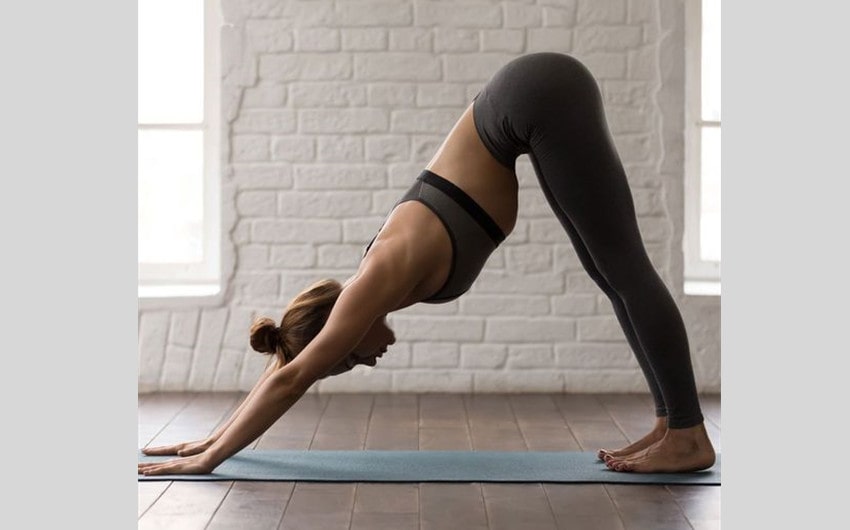
Image source: Pinterest
How to Do It: Start on your hands and knees in a tabletop position. Spread your fingers wide and press firmly into your palms. Lift your hips up and back, forming an inverted “V” shape with your body. Keep your arms and legs straight, heels pressing toward the floor. Relax your head and neck, and engage your core muscles to support the pose.
Benefits: This pose stretches the hamstrings, calves, and spine while strengthening the arms, shoulders, and legs. Adho Mukha Svanasana improves circulation, relieves stress, and energizes the body. It also lengthens the spine and helps alleviate back pain when done with proper alignment.
3. Virabhadrasana I (Warrior I Pose)
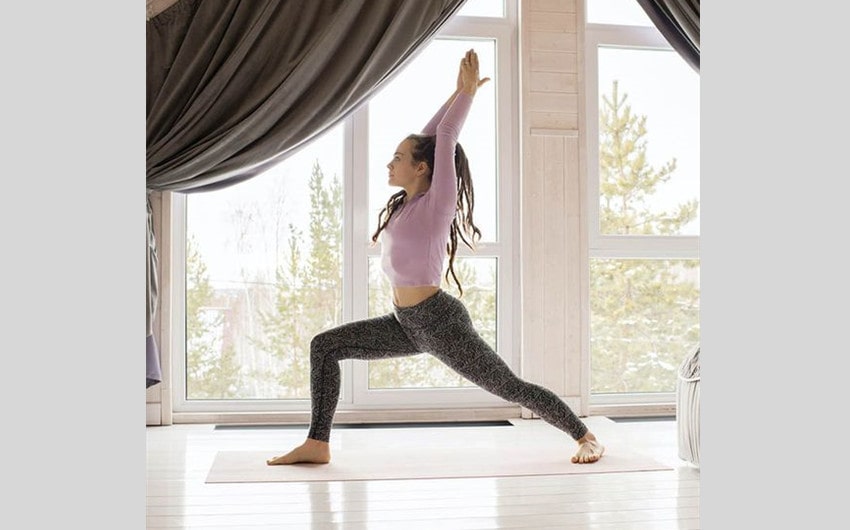
Image source: Pinterest
How to Do It: Begin standing, step one foot back, keeping the front foot facing forward and the back foot angled slightly outward. Bend your front knee over the ankle while keeping the back leg straight. Raise your arms overhead with palms facing each other, and square your hips toward the front. Press down through both feet and lift through your chest as you lengthen your spine.
Benefits: Warrior I strengthens the legs, glutes, and back muscles. It opens the chest and lungs, improving breathing and stamina. This pose also builds focus, balance, and mental resilience, making it a powerful posture for developing strength and concentration.
4. Virabhadrasana II (Warrior II Pose)
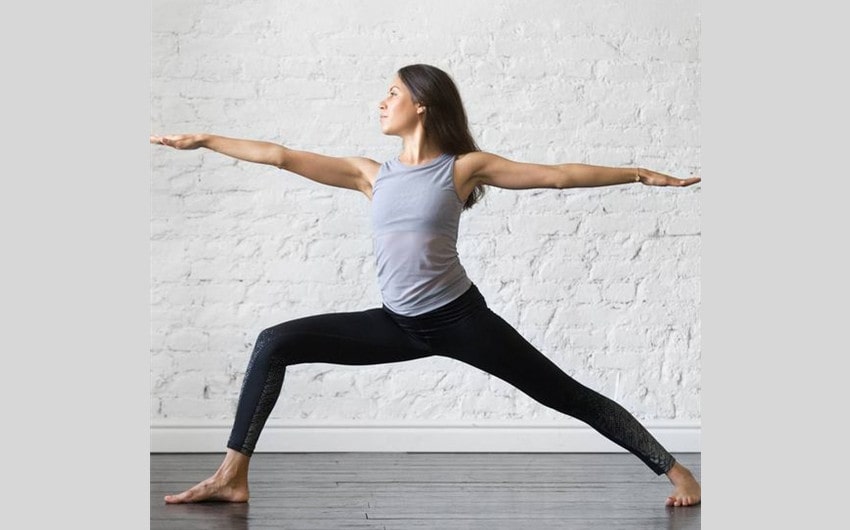
Image source: Pinterest
How to Do It: Start by standing with your legs wide apart. Turn your front foot forward and the back foot slightly inward. Bend your front knee until it’s directly above the ankle, keeping your back leg straight. Extend your arms out to the sides, parallel to the ground, with palms facing down. Gaze over your front hand, keeping your torso tall and your shoulders relaxed.
Benefits: Warrior II strengthens the legs, glutes, and core while stretching the hips and chest. It enhances stamina, balance, and focus. This pose also opens the groin and inner thighs, making it a great hip opener, and improves overall body coordination and endurance.
5. Trikonasana (Triangle Pose)
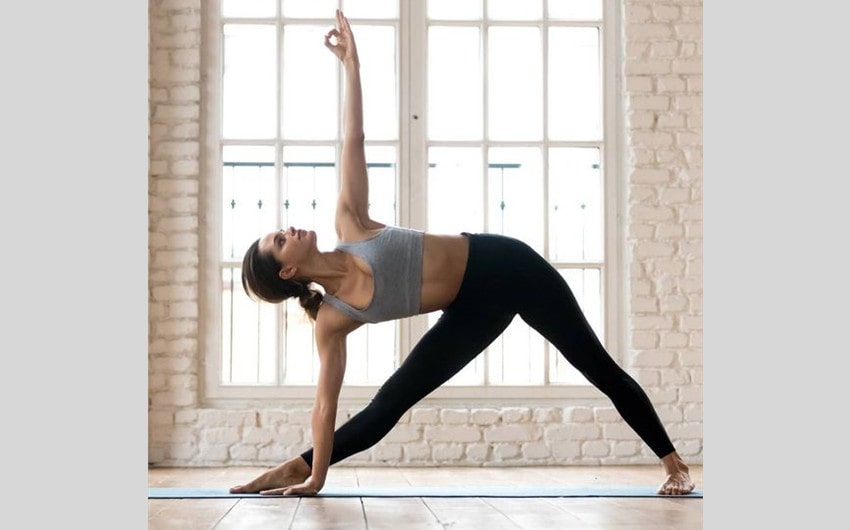
Image source: Pinterest
How to Do It: Stand with your feet wide apart, arms stretched out to the sides at shoulder height. Turn your front foot forward and your back foot slightly inward. Reach your front hand toward your shin, ankle, or the floor while extending your other arm toward the sky. Keep both legs straight and engage your core to support your spine. Turn your head to gaze at the top hand, ensuring your chest is open.
Benefits: Trikonasana stretches the legs, hips, and spine while strengthening the core and legs. It improves flexibility in the hamstrings and hips and enhances balance and stability. This pose also helps improve digestion and reduces stress, as it opens the chest and encourages deep breathing.
6. Vrikshasana (Tree Pose)
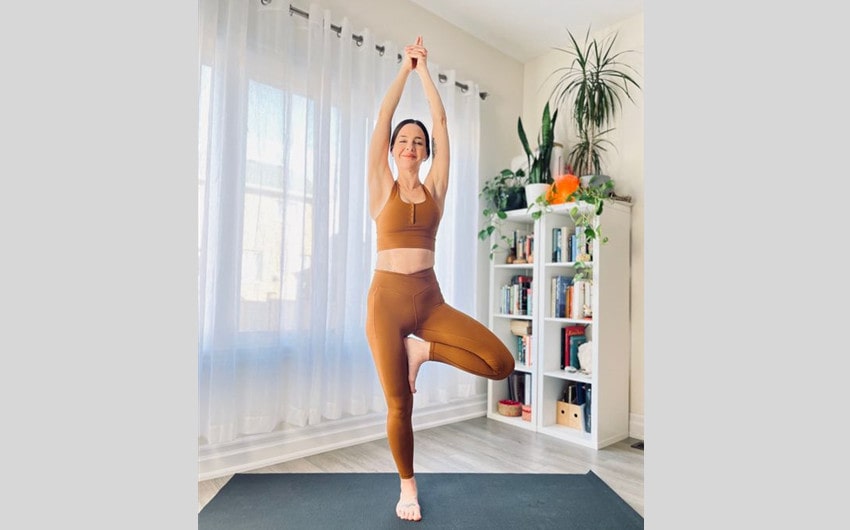
Image source: Pinterest
How to Do It: Begin standing tall in Tadasana (Mountain Pose). Shift your weight onto one foot, keeping the leg strong and straight. Lift the opposite foot and place it on the inner thigh or calf of the standing leg (avoid placing the foot directly on the knee). Press your foot and thigh together for stability. Bring your hands to your heart in a prayer position, or raise your arms overhead with palms facing each other. Keep your gaze steady on a point in front of you.
Benefits: Vrikshasana improves balance, focus, and concentration. It strengthens the legs, ankles, and core while stretching the thighs and groin. This pose also helps to calm the mind and fosters a sense of groundedness, making it excellent for developing mental and physical stability.
7. Utkatasana (Chair Pose)
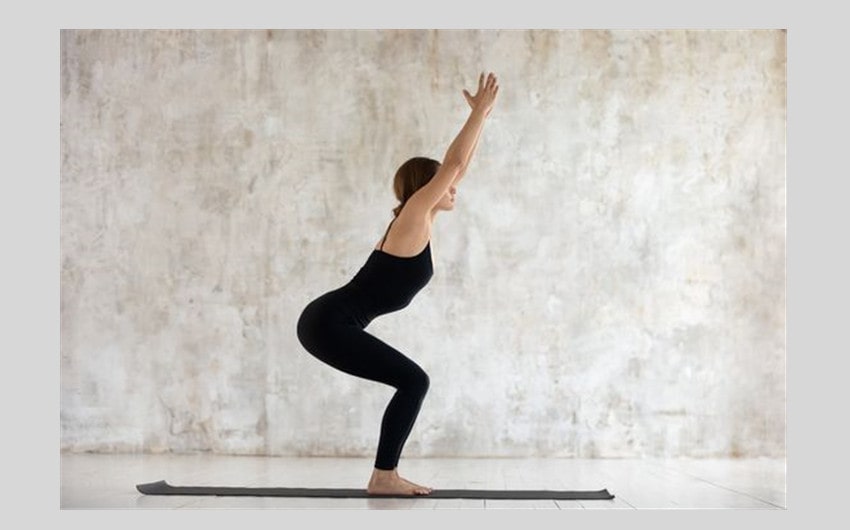
Image source: Pinterest
How to Do It: Start by standing in Tadasana (Mountain Pose). Inhale and raise your arms overhead, keeping them parallel or with palms together. Exhale as you bend your knees, as if sitting back into an imaginary chair. Make sure your thighs are as parallel to the ground as possible while keeping your knees behind your toes. Press your weight back into your heels, and keep your spine long and chest lifted. Gaze forward or slightly upward.
Benefits: Utkatasana strengthens the thighs, calves, and ankles while toning the core and back muscles. It improves endurance and builds stamina, making it a powerful pose for strengthening the lower body. This pose also enhances balance and posture, making it a great way to build overall body strength.
8. Bhujangasana (Cobra Pose)
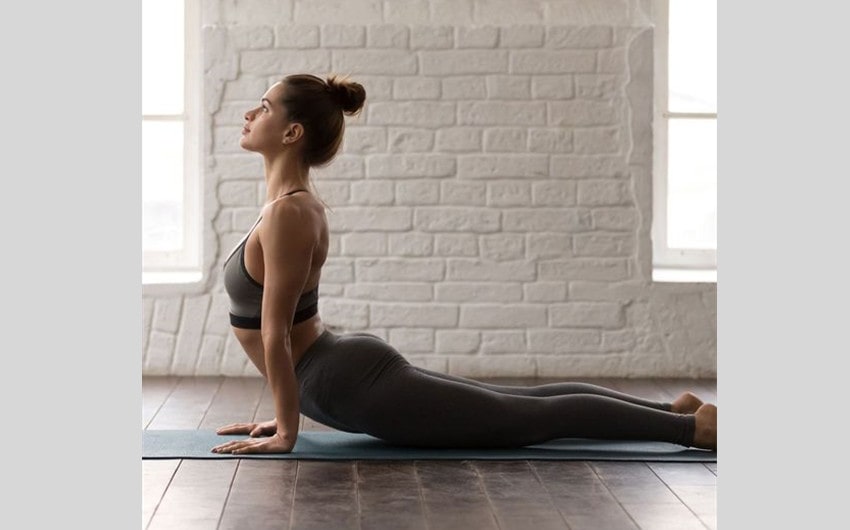
Image source: Pinterest
How to Do It: Begin lying face down on the floor with your legs extended and the tops of your feet pressing into the ground. Place your hands under your shoulders, elbows close to your body. As you inhale, press your palms into the ground and lift your chest, keeping your elbows slightly bent. Your lower body remains on the floor. Draw your shoulders back and away from your ears as you lift your chest forward and upward. Keep your neck long and gaze slightly upward.
Benefits: Bhujangasana stretches the spine, chest, and shoulders while strengthening the arms, back, and glutes. It improves flexibility in the spine and helps to open the chest, promoting deeper breathing. This pose can also help relieve tension in the lower back and improve posture, making it ideal for those who sit for long periods.
9. Savasana (Corpse Pose)
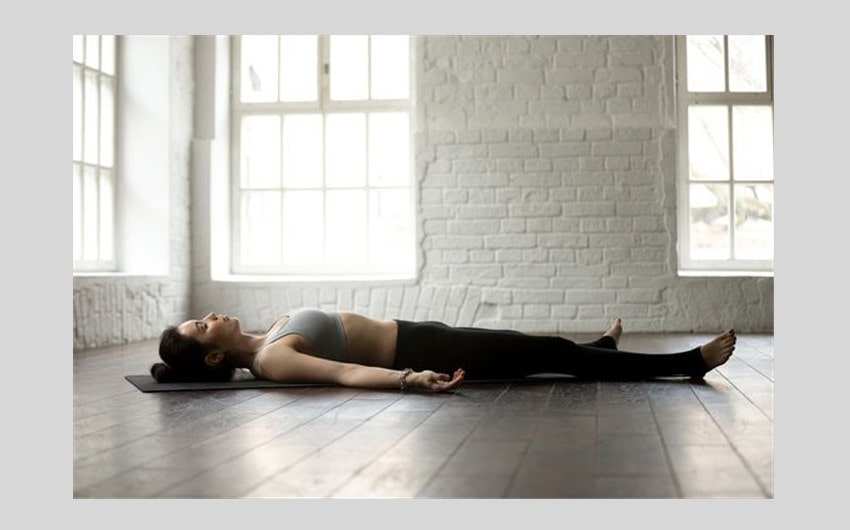
Image source: Pinterest
How to Do It: Lie flat on your back with your legs extended and slightly apart. Allow your arms to rest by your sides, palms facing upward. Close your eyes and relax every part of your body, letting your feet, legs, arms, and head rest naturally on the floor. Focus on your breathing, allowing it to become soft and effortless. Stay in this position for 5 to 10 minutes, or longer if desired, focusing on complete relaxation.
Benefits: Savasana is a restorative pose that promotes relaxation, mental clarity, and stress relief. It helps calm the nervous system, reduce fatigue, and lower blood pressure. This pose is essential for allowing the body to absorb the benefits of the yoga practice, making it a perfect way to end any session. It also improves mindfulness and mental focus.
10. Balasana (Child’s Pose)
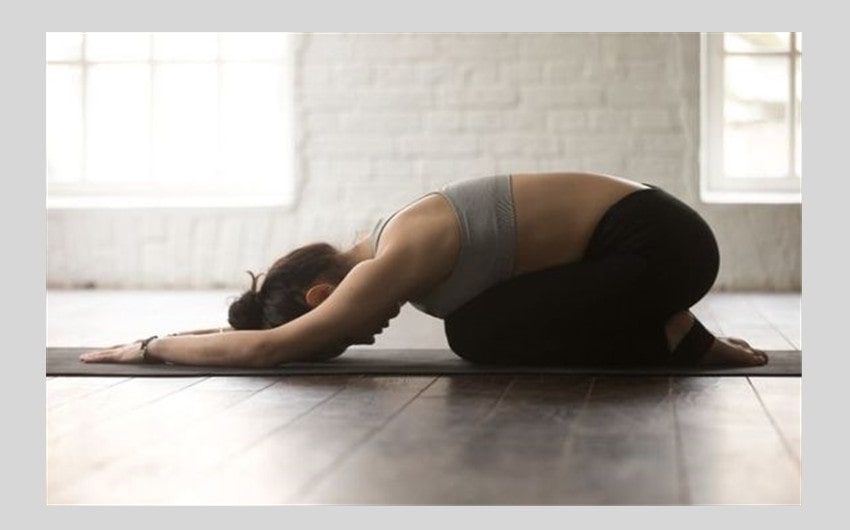
Image source: Pinterest
How to Do It: Start by kneeling on the floor with your big toes touching and your knees spread apart. Sit back onto your heels and extend your arms forward, reaching your palms toward the floor. Allow your forehead to rest on the ground, and relax your neck and shoulders. You can keep your arms extended in front of you or place them by your sides, palms facing upward. Breathe deeply as you settle into the pose.
Benefits: Balasana is a gentle resting pose that stretches the back, hips, and thighs. It helps relieve tension in the spine, shoulders, and neck, making it an excellent pose for relaxation and stress relief. This pose also calms the mind, reduces anxiety, and promotes a sense of inner peace. It is often used as a resting pose during a yoga practice to allow for recovery and reflection.
11. Urdhva Mukha Svanasana (Upward-Facing Dog Pose)
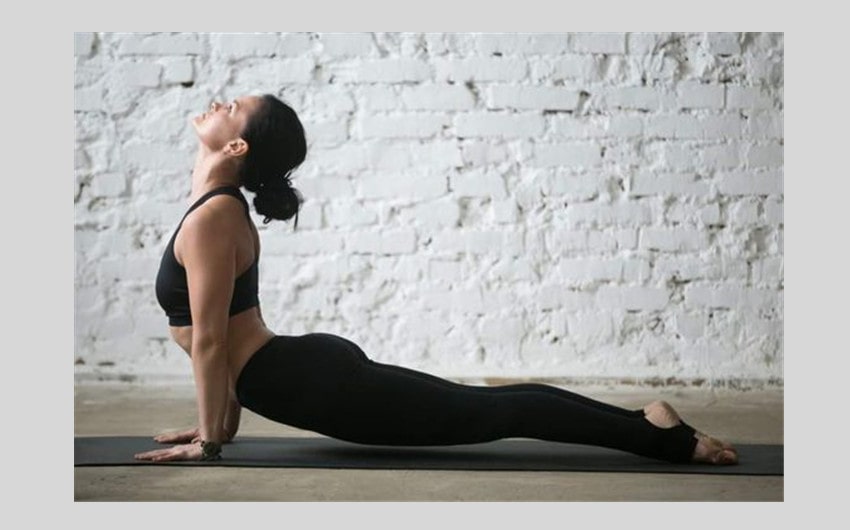
Image source: Pinterest
How to Do It: Start lying face down on your mat with your legs extended, tops of your feet pressing into the floor. Place your hands beside your ribcage, fingers spread wide. Press firmly into your palms as you lift your chest and legs off the ground, straightening your arms. Keep your elbows slightly soft to avoid locking them.
Lift through your chest while keeping your shoulders down and away from your ears. Engage your legs to lift your thighs off the mat, pressing the tops of your feet into the floor.
Benefits: Urdhva Mukha Svanasana strengthens the arms, shoulders, and back while deeply stretching the chest, abdomen, and spine. It promotes better posture by opening the chest and stretching the front body. This pose also helps relieve tension in the back and is known to energize the body, making it a great posture to invigorate you during your yoga practice.
12. Setu Bandhasana (Bridge Pose)
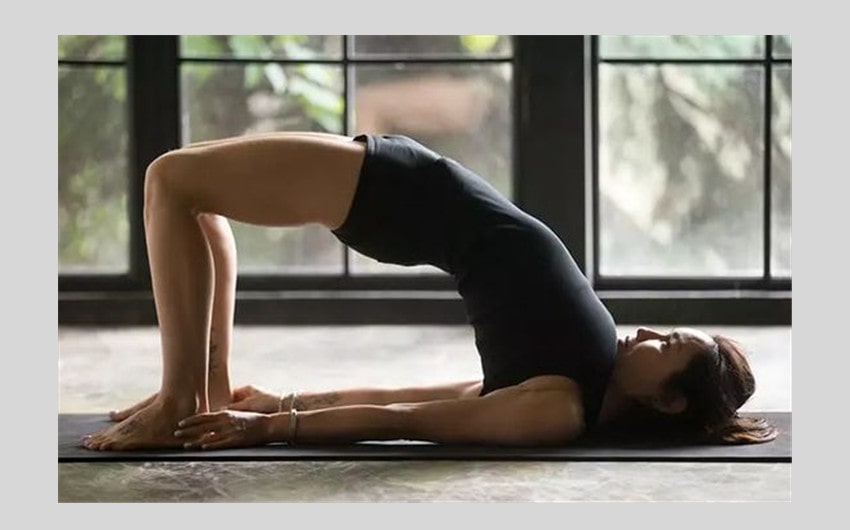
Image source: Pinterest
How to Do It: Begin by lying on your back with your knees bent, feet hip-width apart, and arms resting alongside your body, palms down. Press your feet firmly into the floor and lift your hips toward the ceiling, keeping your thighs parallel. Roll your shoulders underneath you, clasping your hands together beneath your back for support if possible. Engage your glutes and lower back to lift your hips higher, while keeping your chest open and your neck relaxed.
Benefits: Setu Bandhasana strengthens the glutes, hamstrings, and lower back while stretching the chest, neck, and spine. It opens the front body and stimulates the lungs, improving breathing capacity. This pose also calms the brain and reduces stress and anxiety, making it both a strengthening and restorative posture.
13. Paschimottanasana (Seated Forward Bend)
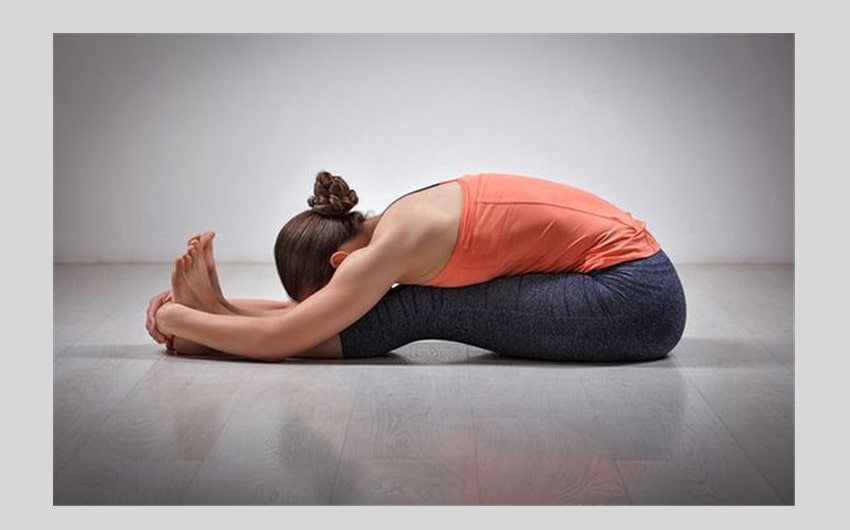
Image source: Pinterest
How to Do It: Sit on the floor with your legs extended straight in front of you, feet together, and spine long. Inhale as you reach your arms overhead, lengthening your spine. Exhale and hinge forward from your hips, reaching your hands toward your feet.
If possible, grasp your feet, ankles, or calves, keeping your back straight. As you fold forward, relax your neck and gaze toward your legs. Breathe deeply into the stretch, aiming to lengthen your spine with each inhale and gently fold deeper with each exhale.
Benefits: Paschimottanasana provides a deep stretch for the hamstrings, lower back, and spine. It helps calm the mind, reduce stress, and promote relaxation. This pose is also known to improve digestion and stimulate the kidneys and liver. It increases flexibility in the hips and lower back while helping to soothe anxiety and fatigue.
14. Navasana (Boat Pose)
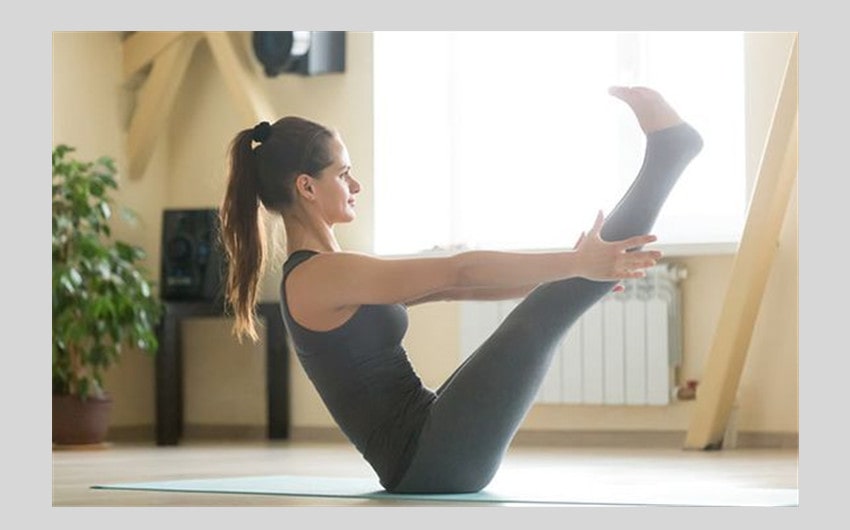
Image source: Pinterest
How to Do It: Start by sitting on the floor with your knees bent and feet flat on the ground. Place your hands behind your knees for support. Lean back slightly, engaging your core to maintain balance. Slowly lift your feet off the floor, bringing your shins parallel to the ground. Extend your arms forward alongside your legs, and if you’re comfortable, straighten your legs to form a “V” shape with your body. Keep your chest lifted, back straight, and focus on engaging your core muscles to hold the pose.
Benefits: Navasana strengthens the core, hip flexors, and spine. It helps improve balance, posture, and overall body awareness. This pose is great for building abdominal strength and toning the muscles of the lower body. Additionally, it helps enhance focus and concentration while encouraging better coordination and body control.
15. Ardha Matsyendrasana (Half Lord of the Fishes Pose)
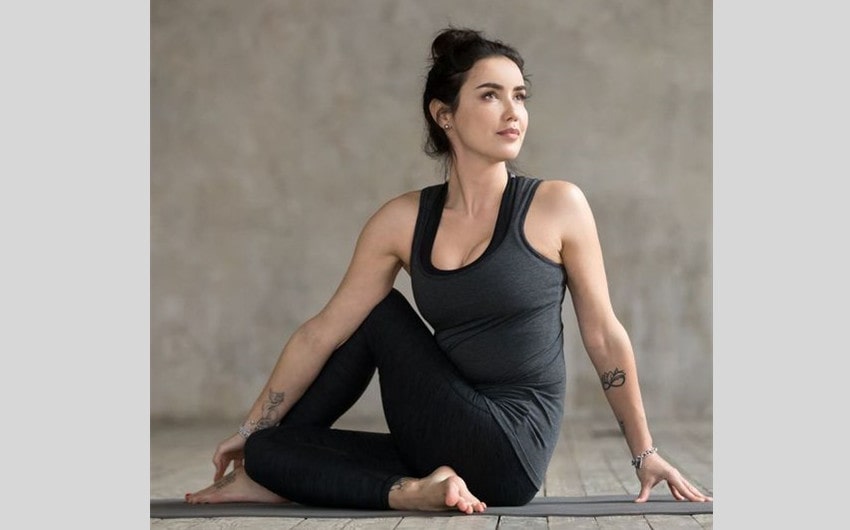
Image source: Pinterest
How to Do It: Sit on the floor with your legs extended. Bend your right knee and place your right foot on the outside of your left thigh. Bend your left leg, bringing your left foot to your right hip. Place your right hand on the floor behind you for support. Inhale and lift your left arm, then exhale as you twist your torso to the right, bringing your left elbow to the outside of your right knee. Lengthen your spine with each inhale and twist deeper with each exhale. Hold for several breaths before switching sides.
Benefits: Ardha Matsyendrasana increases spinal mobility, improves digestion, and stimulates the internal organs. The twisting motion helps detoxify the body by massaging the digestive system and improving circulation. This pose also stretches the shoulders, neck, and hips, while promoting flexibility in the spine. It helps relieve tension and stiffness in the back, making it a great posture for spinal health.
16. Garudasana (Eagle Pose)
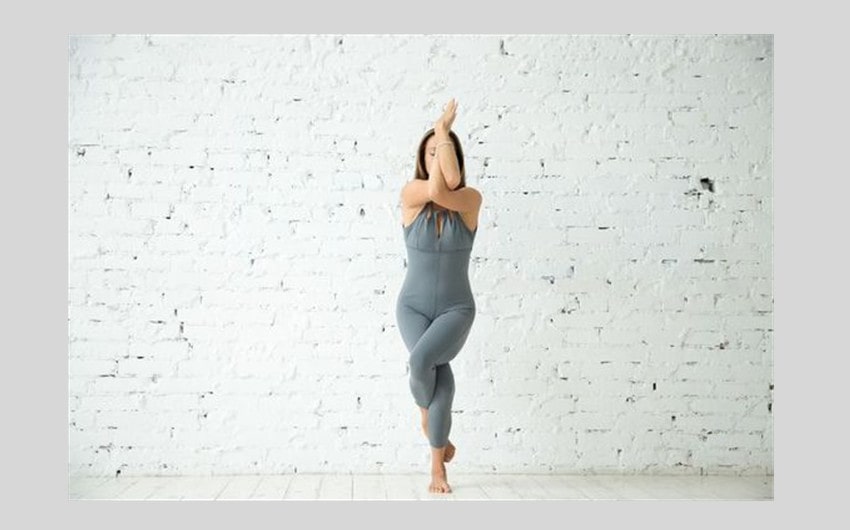
Image source: Pinterest
How to Do It: Begin in a standing position (Tadasana). Slightly bend your knees and lift your right foot, crossing it over your left thigh. Hook your right foot around your left calf if possible. Extend your arms in front of you and cross your left arm over your right at the elbows, then bring the palms of your hands together.
If that’s difficult, bring the backs of your hands together. Hold your gaze steady on a point in front of you and stay balanced while squeezing your arms and legs toward the midline of your body.
Benefits: Garudasana improves balance, focus, and concentration while strengthening the legs and glutes. The pose stretches the upper back, shoulders, and outer thighs. It enhances body coordination and helps to release tension in the shoulders and hips. The focus required for this pose also helps calm the mind and increase mental clarity.
17. Dandasana (Staff Pose)
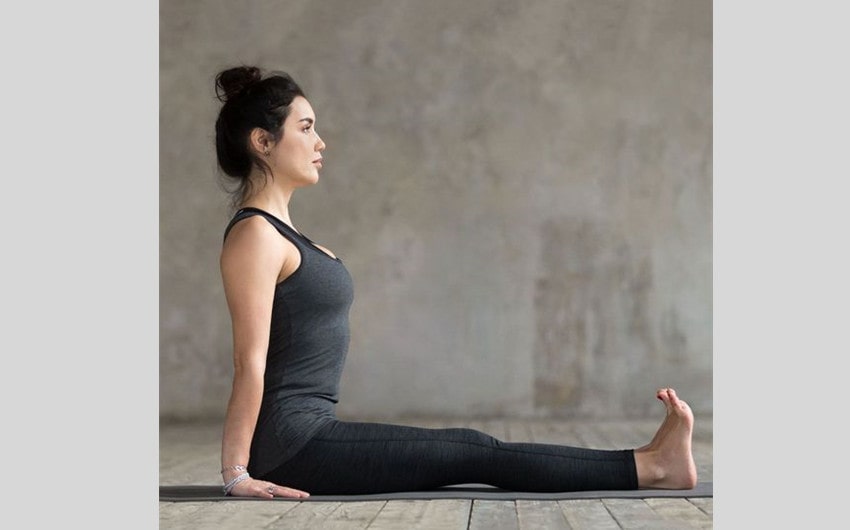
Image source: Pinterest
How to Do It: Sit on the floor with your legs extended straight in front of you. Press your hands into the floor beside your hips and engage your thighs by pressing them into the ground. Flex your feet, keeping them active with toes pointing toward the ceiling. Lift through your spine and chest, lengthening the torso while keeping your neck and shoulders relaxed. Stay tall and keep your chin parallel to the ground as you engage your core.
Benefits: Dandasana strengthens the back muscles and improves posture, making it a foundational pose for seated postures. This pose stretches the hamstrings and calves, increasing flexibility in the legs. It also encourages better alignment of the spine, improving overall body awareness. Dandasana helps to calm the mind and prepares the body for meditation or deeper poses.
18. Padmasana (Lotus Pose)
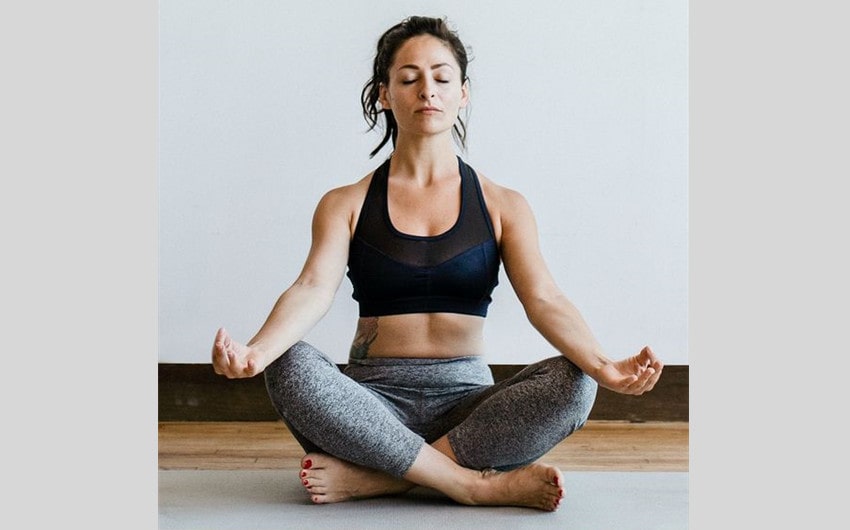
Image source: Pinterest
How to Do It: Begin in a seated position with your legs extended. Bend your right knee and place your right foot on top of your left thigh. Then, bend your left knee and bring your left foot onto your right thigh, with both soles facing upward. Rest your hands on your knees, palms facing upward, with your thumb and index fingers touching in a mudra.
Sit tall, lengthening through your spine, and relax your shoulders while keeping your chin slightly tucked in. Breathe deeply and stay in the pose for several minutes if comfortable.
Benefits: Padmasana is a powerful pose for meditation as it promotes calmness and mental focus. It stretches the hips, knees, and ankles, improving flexibility in the lower body. The pose also encourages proper spinal alignment and deepens the practice of pranayama (breath control). It helps balance the body’s energy flow and promotes a sense of inner peace and serenity.
19. Marjaryasana (Cat Pose)
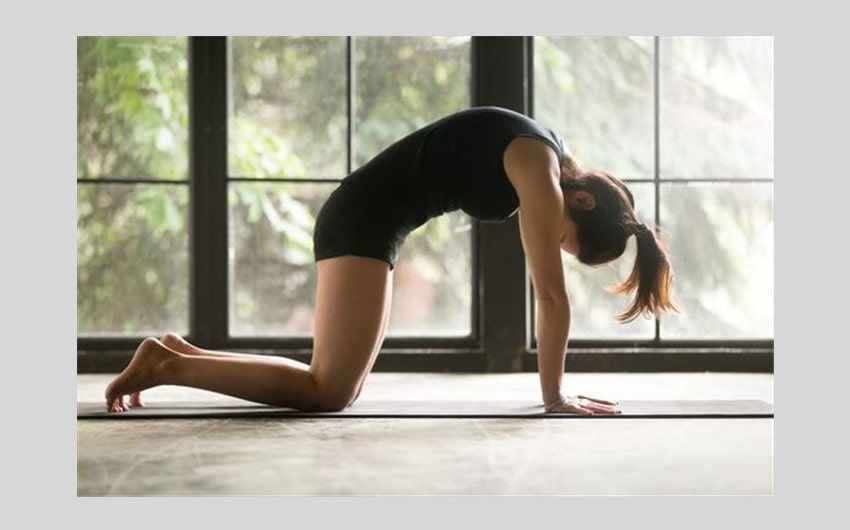
Image source: Pinterest
How to Do It: Start on your hands and knees in a tabletop position, with your wrists directly under your shoulders and your knees under your hips. As you exhale, round your spine upward toward the ceiling, tucking your tailbone and drawing your chin toward your chest. Allow your head to drop naturally and relax your neck. Focus on engaging your abdominal muscles as you round the back completely.
Benefits: Marjaryasana stretches the spine, neck, and back muscles while improving flexibility in the spine. This pose helps release tension in the upper back and shoulders, making it an excellent counter-stretch after long periods of sitting or standing. It also massages the internal organs, promoting better digestion and stimulating the kidneys and adrenal glands.
20. Bitilasana (Cow Pose)
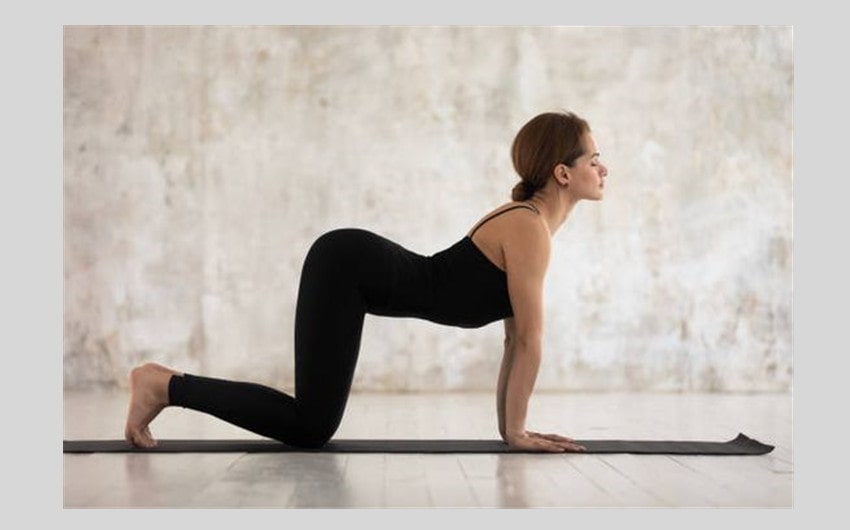
Image source: Pinterest
How to Do It: Begin in the same tabletop position as Marjaryasana. As you inhale, arch your back by lifting your chest and tailbone toward the ceiling, allowing your belly to drop toward the floor. Keep your head lifted and gaze forward or slightly upward. Maintain a gentle curve in your spine, avoiding excessive compression in the lower back. This pose is often paired with Cat Pose (Marjaryasana) for a fluid, moving stretch.
Benefits: Bitilasana stretches the front body, including the chest, abdomen, and neck, while gently massaging the spine. This pose improves flexibility in the spine and helps relieve tension in the lower back. Like Cat Pose, it stimulates the internal organs, aiding digestion. When practiced together with Cat Pose, these movements promote spinal health and improve overall mobility.
21. Anjaneyasana (Low Lunge)
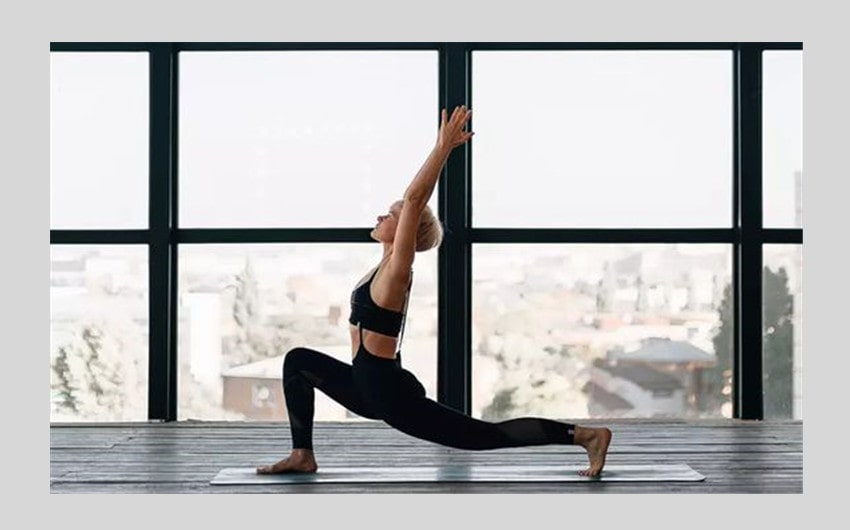
Image source: Pinterest
How to Do It: Begin in a downward-facing dog position (Adho Mukha Svanasana), then step your right foot forward between your hands, lowering your left knee to the mat. Ensure your right knee is directly above your ankle and your back leg is extended with the top of your foot resting on the floor. As you inhale, lift your torso and arms toward the ceiling, keeping your shoulders relaxed. Reach up and slightly back, opening your chest. Hold for several breaths, then switch sides.
Benefits: Anjaneyasana stretches the hips, groin, and thighs while strengthening the legs and arms. It opens the chest and shoulders, improving flexibility and posture. This pose also lengthens the spine and helps relieve tension in the hips, making it especially beneficial for those who sit for long periods. Additionally, it stimulates balance, mental focus, and stamina.
22. Ustrasana (Camel Pose)
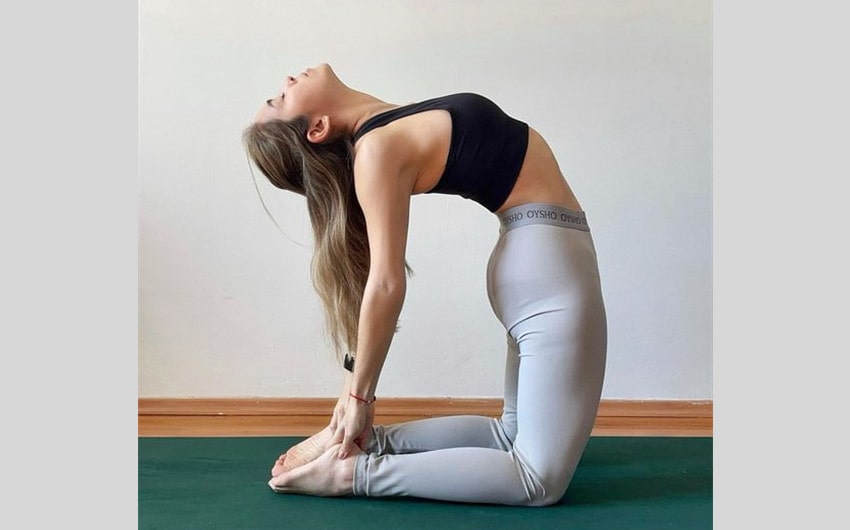
Image source: Pinterest
How to Do It: Start by kneeling on the mat with your knees hip-width apart and the tops of your feet pressing into the floor. Place your hands on your lower back, fingers pointing downward. As you inhale, lift your chest and arch your back, gently pressing your hips forward. Reach your hands back to grasp your heels if possible, keeping your head lifted or gently dropping it back. Focus on opening your chest and lengthening your spine without collapsing into the lower back.
Benefits: Ustrasana is a deep backbend that stretches the entire front body, including the chest, abdomen, and thighs. It strengthens the back muscles and improves spinal flexibility. This pose helps open the heart and lungs, promoting better breathing and relieving fatigue. Ustrasana also stimulates the adrenal glands and is known to improve posture and boost energy levels.
23. Halasana (Plow Pose)
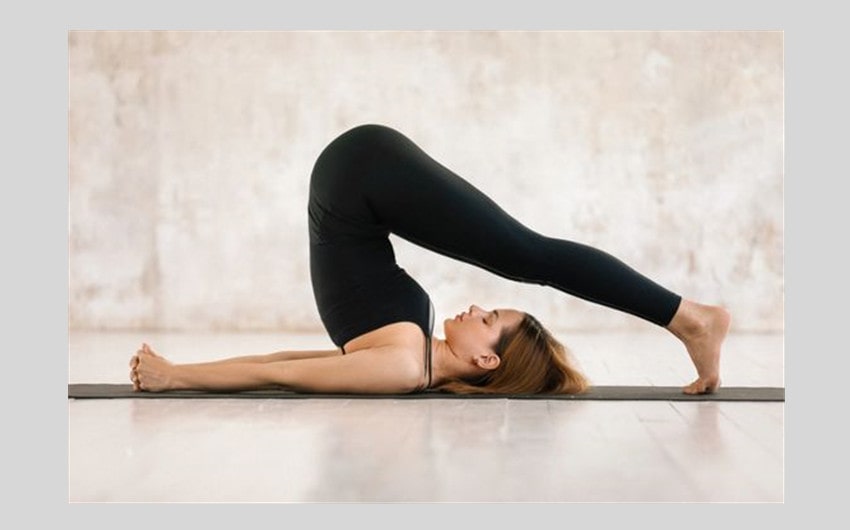
Image source: Pinterest
How to Do It: Begin by lying flat on your back with your arms resting by your sides. Lift your legs over your head, supporting your lower back with your hands as you roll your hips upward. Continue lifting your legs until your toes touch the floor behind your head. Keep your legs straight and your hands on your lower back or extend them along the floor behind you. Relax your neck and allow your chest to rest against your chin.
Benefits: Halasana stretches the shoulders, spine, and neck while calming the nervous system. This pose promotes flexibility in the spine and improves circulation. It helps reduce stress, stimulates the thyroid gland, and boosts the immune system. Additionally, Halasana is known to improve digestion and relieve fatigue, making it a deeply restorative inversion.
24. Salamba Sarvangasana (Supported Shoulder Stand)
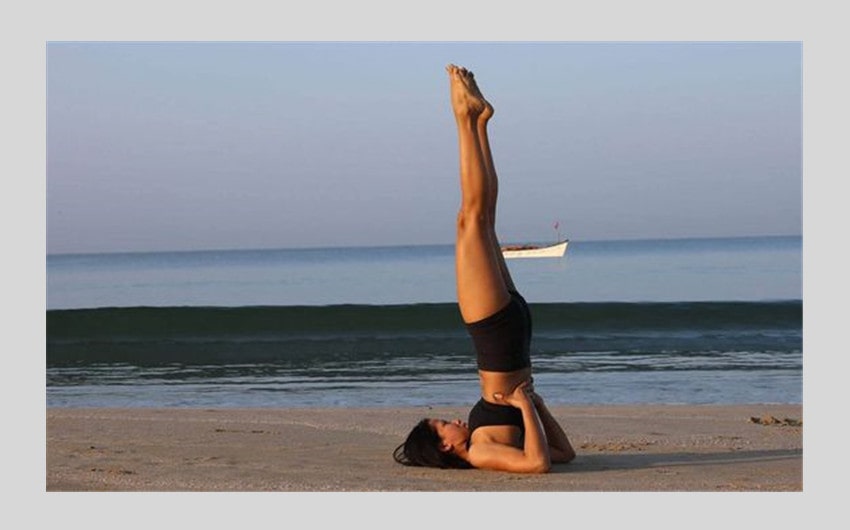
Image source: Pinterest
How to Do It: Start by lying on your back with your arms alongside your body. Bend your knees and lift your legs, bringing them over your head into a plow pose (Halasana). Then, lift your hips and support your lower back with your hands as you extend your legs straight up toward the ceiling. Keep your elbows on the floor and your weight balanced on your shoulders and upper arms. Gaze softly toward your chest, and hold the pose for several breaths.
Benefits: Salamba Sarvangasana strengthens the legs, back, and core while improving balance and coordination. It helps to calm the mind and reduce stress by promoting relaxation. This inversion stimulates the thyroid and parathyroid glands, which regulate metabolism and calcium levels in the body. Shoulder Stand also improves circulation and digestion, making it a therapeutic pose for both physical and mental well-being.
25. Viparita Karani (Legs-Up-The-Wall Pose)
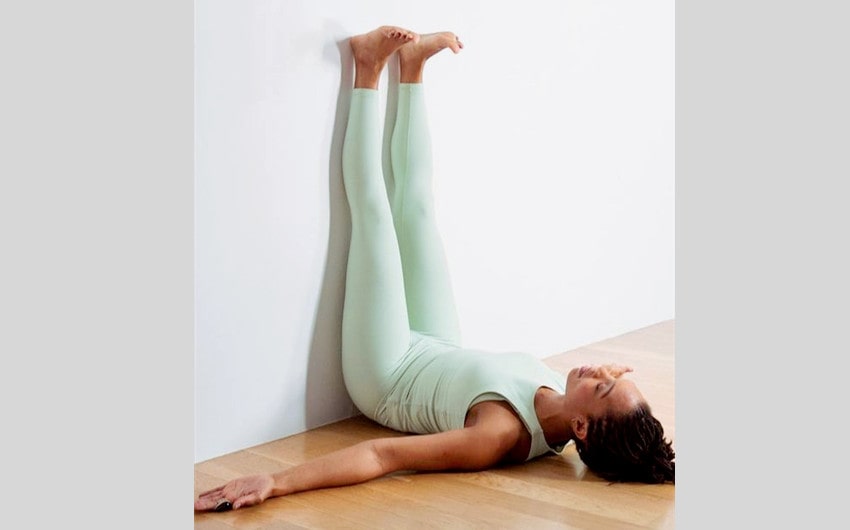
Image source: Pinterest
How to Do It: Begin by sitting with your side close to a wall. Gently lie on your back while swinging your legs up the wall, keeping your sit bones as close to the wall as comfortable. Allow your arms to rest by your sides with palms facing upward. Close your eyes, breathe deeply, and relax into the pose. Stay in this position for several minutes, focusing on relaxation and deep breathing.
Benefits: Viparita Karani is a gentle inversion that promotes relaxation and relieves stress. It helps reduce swelling in the legs and feet by improving circulation and relieving tension in the lower back. This pose is known for its calming effects on the nervous system, making it ideal for combating anxiety and fatigue. It also stretches the back of the legs and lower back, promoting flexibility and restfulness.
26. Shirshasana (Headstand)
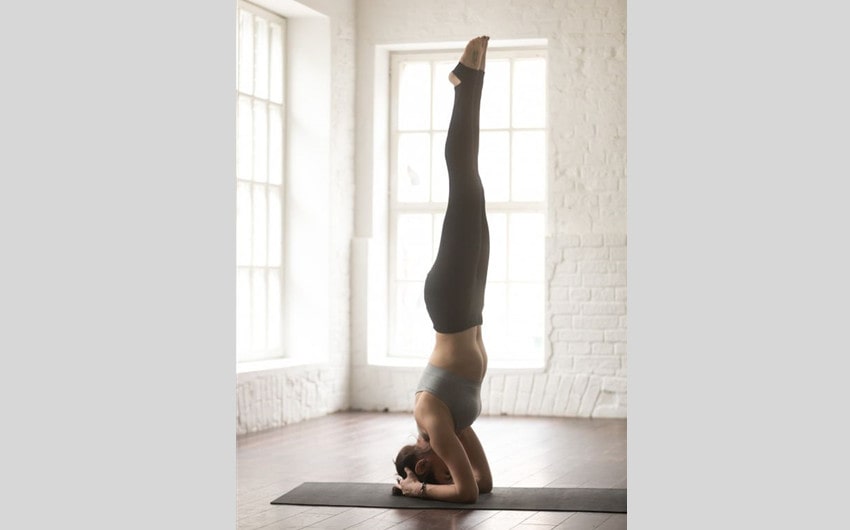
Image source: Pinterest
How to Do It: Start in a kneeling position. Interlace your fingers and place your forearms on the ground, creating a triangle shape with your arms. Position the crown of your head on the ground with your hands supporting the back of your head. Tuck your toes under and lift your hips, walking your feet closer to your head.
Slowly lift your feet off the ground, bringing your knees toward your chest. Engage your core and extend your legs straight up, keeping your body in a straight line. Hold the pose for several breaths, keeping your focus steady.
Benefits: Shirshasana strengthens the core, arms, shoulders, and back while improving balance and focus. It helps increase blood flow to the brain, stimulating the nervous system and improving concentration. This pose also relieves stress, promotes mental clarity, and enhances overall body awareness. Headstands are known to improve circulation and boost energy levels, making them a powerful inversion for both physical and mental health.
27. Bakasana (Crow Pose)
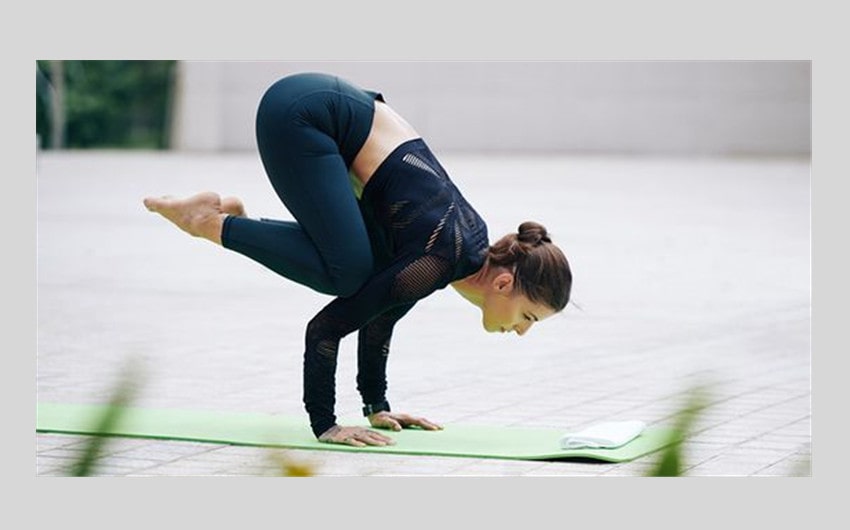
Image source: Pinterest
How to Do It: Start in a squat position with your feet hip-width apart. Place your hands on the ground in front of you, shoulder-width apart, and spread your fingers wide. Lift your hips and bring your knees to the backs of your upper arms. Shift your weight forward, keeping your elbows bent, and slowly lift one foot off the ground, then the other.
Balance on your hands with your knees resting on your upper arms, engaging your core to stabilize the pose. Keep your gaze focused slightly ahead of you to maintain balance.
Benefits: Bakasana strengthens the arms, wrists, shoulders, and core while improving balance and coordination. This pose challenges mental focus and builds confidence as you learn to balance on your hands. Crow pose also stretches the upper back and improves overall body awareness. It’s a great posture for enhancing arm strength and preparing for more advanced arm balances.
28. Parsvottanasana (Pyramid Pose)
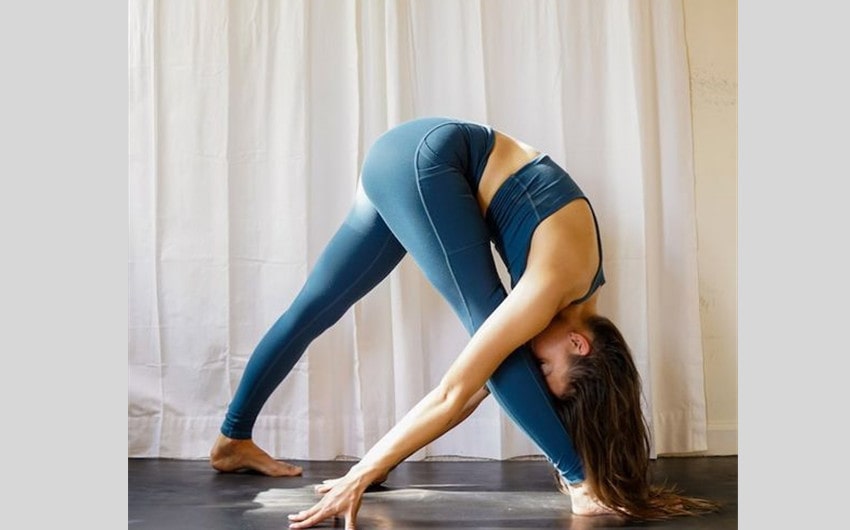
Image source: Pinterest
How to Do It: Begin by standing in Tadasana (Mountain Pose), then step one foot back about three to four feet. Turn your back foot slightly outward and square your hips to the front. As you inhale, lengthen your spine, and as you exhale, hinge forward at the hips, reaching your hands toward the ground or onto blocks on either side of your front foot.
Keep your legs straight, with both feet pressing firmly into the floor. Hold the pose for several breaths, focusing on lengthening the spine and maintaining even weight distribution.
Benefits: Parsvottanasana deeply stretches the hamstrings, calves, and hips while strengthening the legs. This pose improves balance, posture, and flexibility in the spine. It also helps relieve tension in the neck, shoulders, and back. The forward bend in Pyramid Pose promotes calmness, reduces stress, and enhances focus and mental clarity.
29. Parighasana (Gate Pose)
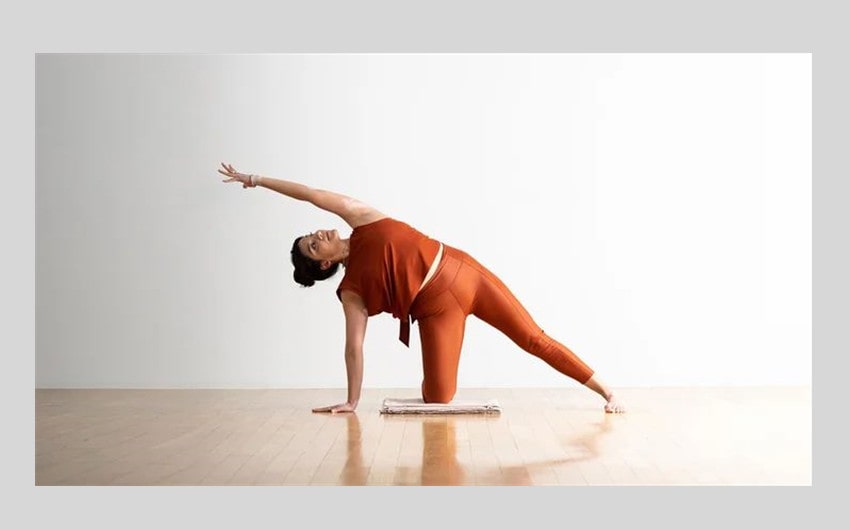
Image source: Pinterest
How to Do It: Start by kneeling on the mat with your knees hip-width apart. Extend your right leg out to the side, keeping your foot flat on the ground and your toes pointing forward. Inhale and raise your left arm overhead, then exhale as you bend sideways toward your extended leg, reaching your right hand down toward your shin or ankle. Keep your chest open and your torso long as you stretch through your left side. Hold for several breaths, then switch sides.
Benefits: Parighasana stretches the sides of the torso, including the obliques, intercostal muscles, and hips. It improves flexibility in the spine and promotes a deep stretch in the hamstrings. This pose also helps open the chest and lungs, encouraging deeper breathing. Gate Pose enhances body awareness, balance, and overall flexibility while relieving tension in the lower back.
30. Supta Baddha Konasana (Reclining Bound Angle Pose)
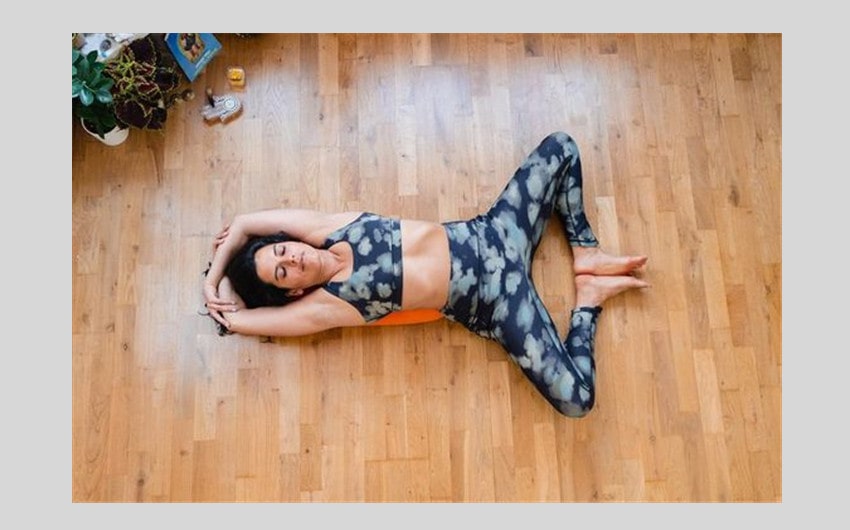
Image source: Pinterest
How to Do It: Begin by sitting on the floor with the soles of your feet touching and your knees falling open to the sides. Slowly lie back onto the mat, allowing your arms to rest by your sides with palms facing upward. If necessary, place cushions or blocks under your knees for support. Relax your shoulders and focus on deep breathing as you settle into the pose. Stay here for several minutes, allowing your body to fully relax and open.
Benefits: Supta Baddha Konasana gently opens the hips, groin, and inner thighs while promoting deep relaxation. This restorative pose calms the nervous system, relieves stress, and promotes mental clarity. It also helps to improve flexibility in the hips and lower back. Reclining Bound Angle Pose is often used as a restorative posture at the end of a practice to encourage relaxation and mindfulness.
31. Supta Padangusthasana (Reclining Hand-to-Big-Toe Pose)
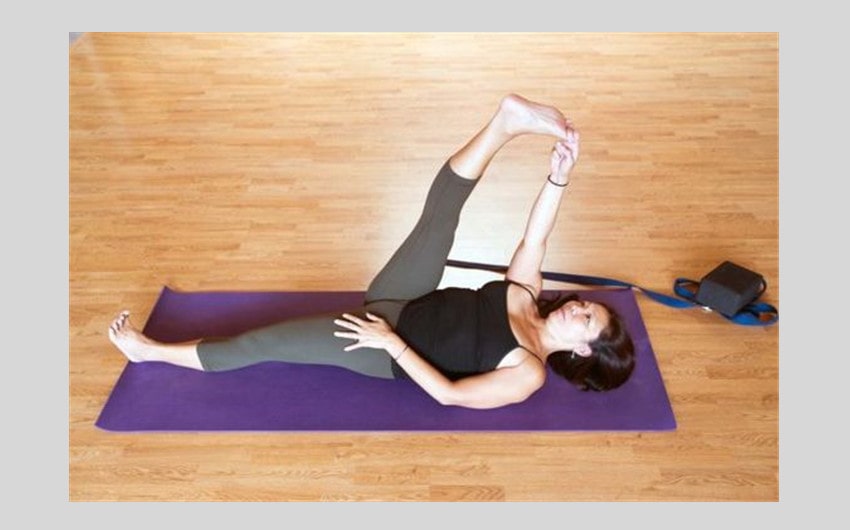
Image source: Pinterest
How to Do It: Start by lying on your back with your legs extended. Bend your right knee and bring your thigh toward your chest. Loop a yoga strap or belt around the arch of your right foot, holding the ends of the strap in both hands. Extend your right leg toward the ceiling, keeping your left leg straight on the floor. Gently pull on the strap to stretch your right hamstring, while keeping your shoulders relaxed and your lower back grounded. Hold for several breaths, then switch sides.
Benefits: Supta Padangusthasana provides a deep stretch for the hamstrings, calves, and lower back. It helps improve flexibility in the legs and hips while also strengthening the thighs and knees. This pose is excellent for relieving tension in the lower back and for lengthening the spine. The reclined position also calms the mind, reduces stress, and can help alleviate insomnia.
32. Malasana (Garland Pose)
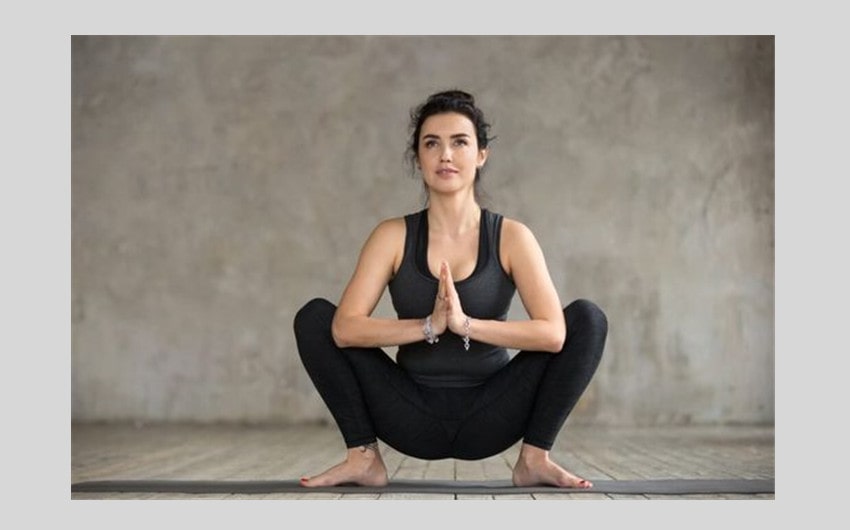
Image source: Pinterest
How to Do It: Begin standing with your feet slightly wider than hip-width apart. Squat down, bringing your hips close to the floor, and keep your heels grounded (or use a rolled-up blanket under your heels if needed). Press your elbows into the inside of your knees, bringing your palms together at your chest in a prayer position. Keep your spine straight, chest lifted, and shoulders relaxed. Hold for several breaths, focusing on the deep stretch in your hips and inner thighs.
Benefits: Malasana is a deep squat that stretches the hips, groin, and ankles while strengthening the legs and core. This pose improves flexibility in the hips and lower back, making it a great stretch for people who spend a lot of time sitting. Malasana also helps improve digestion by stimulating the abdominal organs. The grounding nature of this pose promotes calmness and relaxation.
33. Janu Sirsasana (Head-to-Knee Forward Bend)
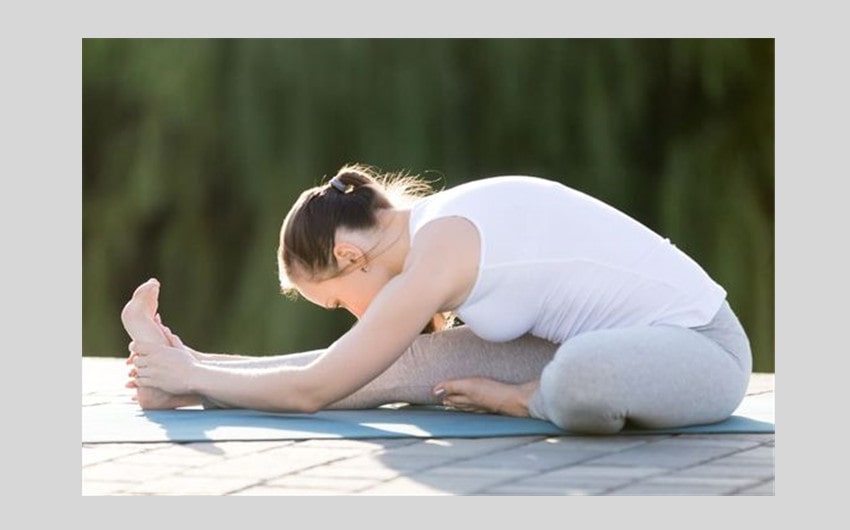
Image source: Pinterest
How to Do It: Sit on the floor with your legs extended in front of you. Bend your right knee and place the sole of your foot against the inner left thigh. Inhale and lengthen your spine, reaching your arms overhead. Exhale as you fold forward from the hips, reaching toward your left foot or shin with both hands. Keep your back long and your shoulders relaxed as you gently stretch your hamstring and lower back. Hold for several breaths, then switch sides.
Benefits: Janu Sirsasana provides a deep stretch for the hamstrings, lower back, and spine while also opening the hips. It helps improve flexibility in the legs and is great for relieving tension in the back. This pose also calms the mind and stimulates digestion, making it ideal for relaxation and stress relief. It’s commonly used as a preparatory pose for seated forward bends and other deep stretches.
34. Matsyasana (Fish Pose)
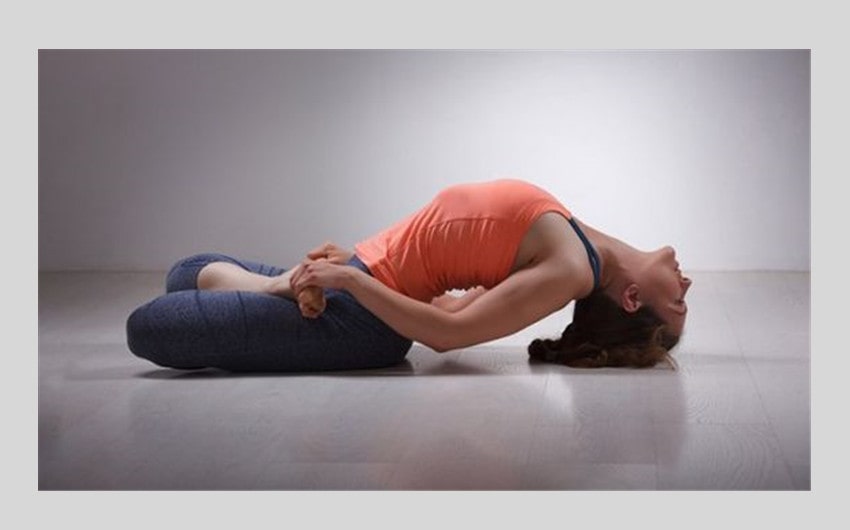
Image source: Pinterest
How to Do It: Start by lying on your back with your legs extended. Place your hands under your hips, palms facing down. As you inhale, press your elbows into the ground and lift your chest, creating an arch in your upper back. Gently rest the top of your head on the floor, keeping your chest lifted and your throat open. Keep your legs extended and active, pressing the tops of your feet into the floor. Hold the pose for several breaths, focusing on the stretch in your chest and throat.
Benefits: Matsyasana stretches the chest, throat, and neck while strengthening the muscles of the upper back. This pose promotes deep breathing and opens the lungs, making it beneficial for improving respiratory function. It also helps improve posture by strengthening the muscles of the back and relieving tension in the neck and shoulders. Matsyasana is a heart-opening pose that promotes relaxation and stimulates the thyroid gland.
35. Parivrtta Trikonasana (Revolved Triangle Pose)
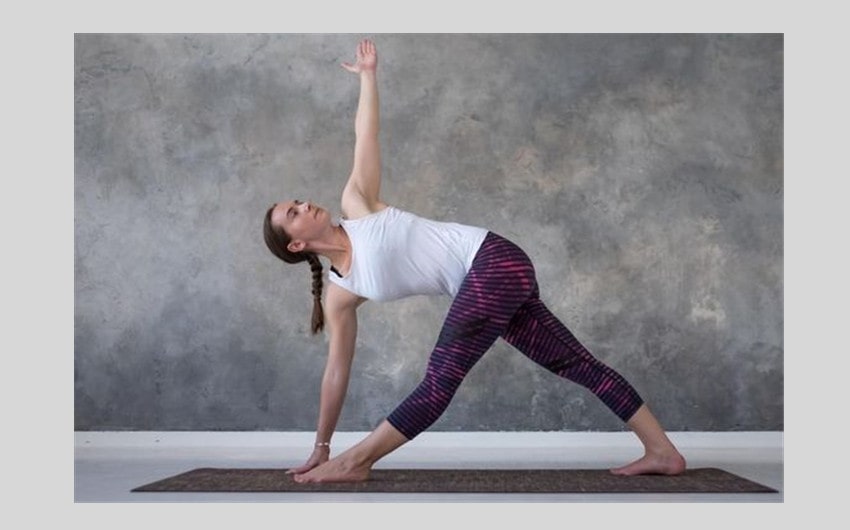
Image source: Pinterest
How to Do It: Start standing with your feet about three feet apart. Turn your right foot forward and your left foot slightly inward. Extend your arms out to the sides at shoulder height. Inhale and lengthen your spine, then exhale and twist your torso toward your right leg, bringing your left hand down to the outside of your right foot (or onto a block for support).
Extend your right arm toward the ceiling, keeping your gaze upward or looking down at the floor for balance. Hold for several breaths, then switch sides.
Benefits: Parivrtta Trikonasana strengthens the legs, hips, and core while improving balance and stability. The twisting motion of this pose helps stimulate the digestive system, detoxifying the internal organs. It also stretches the hamstrings, calves, and spine while increasing flexibility in the hips and shoulders. This pose promotes mental clarity and focus, as the balance and twist require concentration.
36. Eka Pada Rajakapotasana (Pigeon Pose)
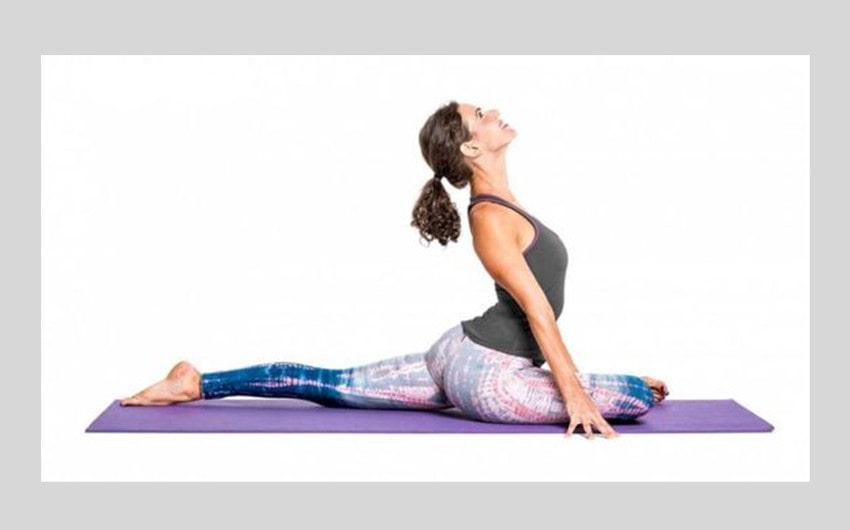
Image source: Pinterest
How to Do It: Start in a tabletop position on your hands and knees. Bring your right knee forward and place it behind your right wrist, with your right ankle near your left wrist. Extend your left leg straight behind you, with the top of your foot resting on the floor. Square your hips to the front and lower your torso down over your front leg, either resting on your forearms or extending your arms forward. Hold for several breaths, then switch sides.
Benefits: Pigeon Pose deeply stretches the hips, thighs, and lower back, helping to release tension in these areas. It increases flexibility in the hips and groin while strengthening the lower body. This pose is particularly effective for opening the hips, which can help alleviate lower back pain. The forward fold in this posture also promotes relaxation and stress relief.
37. Baddha Konasana (Bound Angle Pose)
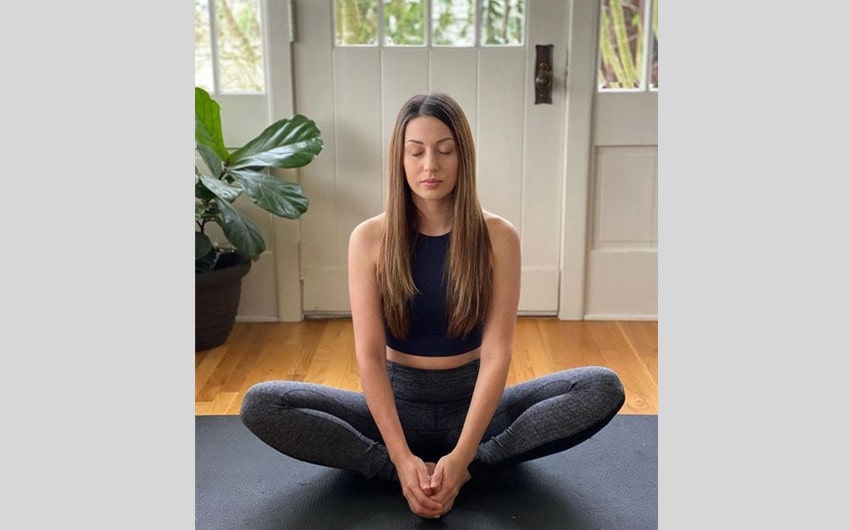
Image source: Pinterest
How to Do It: Begin seated with your legs extended in front of you. Bend your knees and bring the soles of your feet together, allowing your knees to drop toward the floor. Hold your feet or ankles with your hands, and as you inhale, lengthen your spine. On the exhale, gently fold forward, keeping your back straight and shoulders relaxed. Hold for several breaths, focusing on deep breathing and allowing your hips to open.
Benefits: Baddha Konasana stretches the hips, groin, and inner thighs while improving flexibility in the lower body. It helps stimulate the digestive and reproductive systems, making it beneficial for women during menstruation or pregnancy. This pose also promotes relaxation by calming the nervous system, reducing stress, and encouraging mindfulness.
38. Utkata Konasana (Goddess Pose)
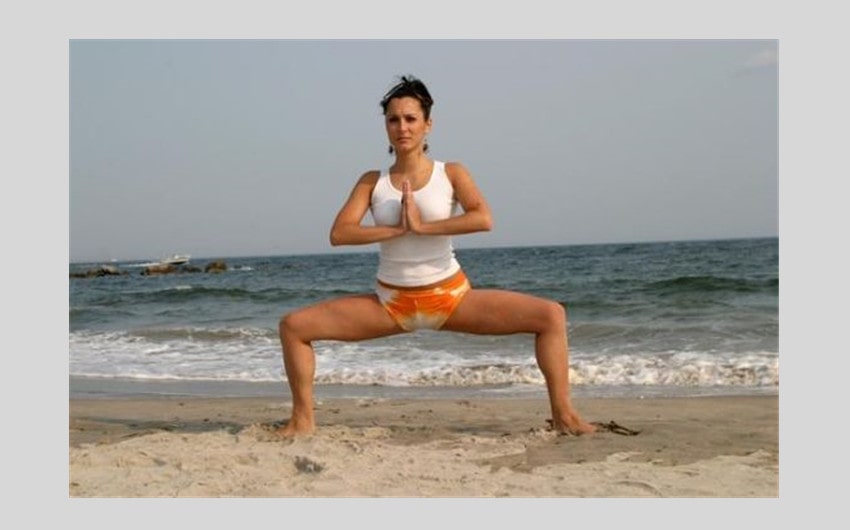
Image source: Pinterest
How to Do It: Start standing with your feet wide apart, toes pointing out at a 45-degree angle. Bend your knees deeply, sinking your hips down toward the level of your knees, similar to a squat. Keep your spine straight and your chest lifted. Bring your arms up to shoulder height, bending your elbows and spreading your fingers wide, creating a “goalpost” shape with your arms. Engage your core and hold for several breaths, focusing on balance and strength.
Benefits: Goddess Pose strengthens the thighs, calves, glutes, and core while improving balance and stability. It also stretches the hips and groin, increasing flexibility in the lower body. This powerful posture enhances stamina and endurance, making it an excellent pose for building strength. Utkata Konasana is also known to energize the body and boost mental focus.
39. Ardha Chandrasana (Half Moon Pose)
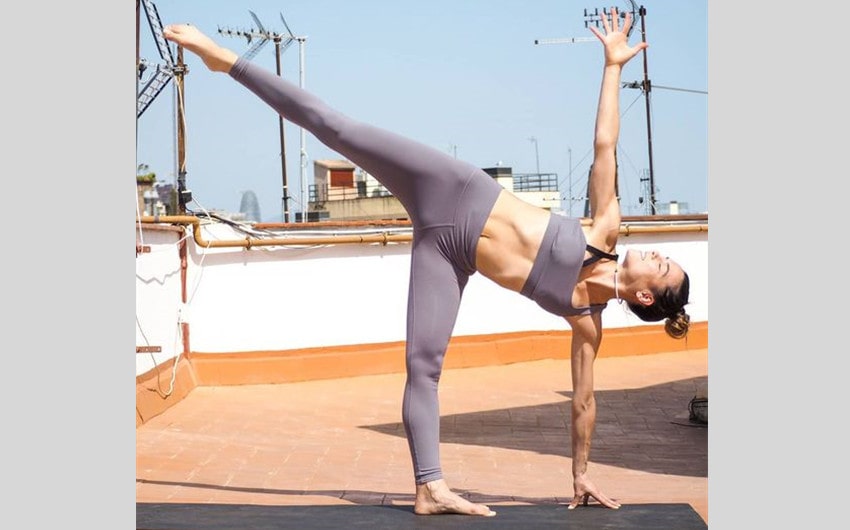
Image source: Pinterest
How to Do It: Begin in a standing position with your feet together. Step your right foot forward and bend your knee slightly. Place your right hand on the floor (or a block) in front of your right foot. Shift your weight onto your right leg as you lift your left leg behind you, straightening it parallel to the floor. Extend your left arm toward the ceiling and open your chest toward the side. Keep your gaze on the ground or up toward your left hand. Hold for several breaths, then switch sides.
Benefits: Ardha Chandrasana strengthens the legs, ankles, and core while improving balance and coordination. It stretches the hamstrings, hips, and chest, promoting flexibility in the lower body. This pose also helps improve posture by strengthening the spine and shoulders. Half Moon Pose is excellent for enhancing focus and concentration, as the balance required helps improve mental clarity.
40. Tittibhasana (Firefly Pose)
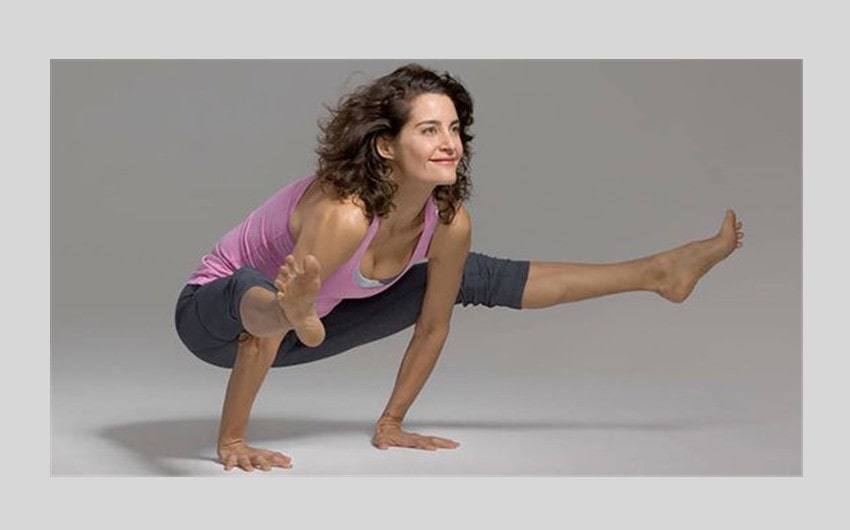
Image source: Pinterest
How to Do It: Start in a standing position with your feet slightly wider than hip-width apart. Bend your knees and squat down, bringing your torso between your legs. Place your hands on the floor behind your feet, shoulder-width apart.
Slowly shift your weight onto your hands as you lift your feet off the floor, extending your legs out straight in front of you, parallel to the ground. Engage your core and straighten your arms, keeping your gaze forward. Hold the pose for several breaths before lowering back down.
Benefits: Tittibhasana strengthens the arms, wrists, shoulders, and core while improving balance and coordination. This advanced arm balance challenges flexibility in the hamstrings and hips while building strength in the upper body. Firefly Pose also increases mental focus and concentration, requiring both physical and mental endurance. It’s an invigorating posture that promotes overall body awareness and control.
41. Chaturanga Dandasana (Four-Limbed Staff Pose)
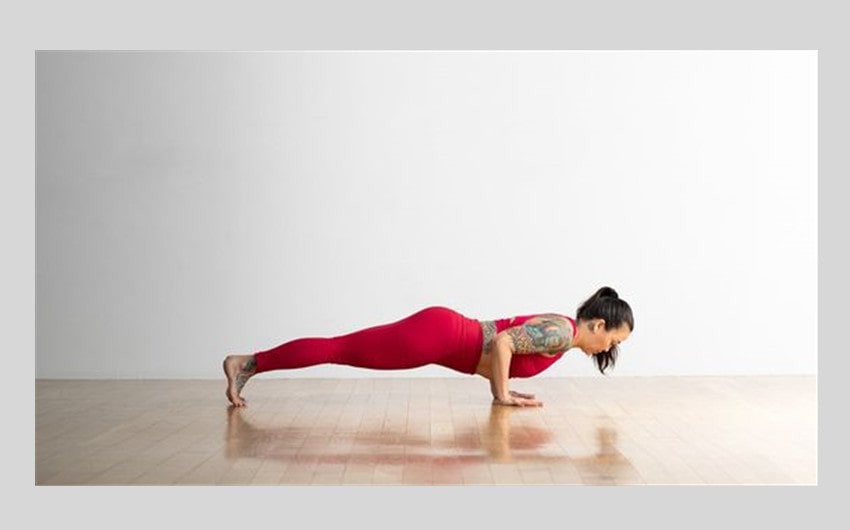
Image source: Pinterest
How to Do It: Start in a high plank position with your hands directly under your shoulders, feet hip-width apart, and your body in a straight line. Shift your weight slightly forward, coming onto the balls of your feet. Slowly lower your body by bending your elbows at a 90-degree angle, keeping them close to your ribcage. Engage your core, legs, and arms, keeping your body parallel to the floor. Hold briefly before transitioning to upward-facing dog or plank.
Benefits: Chaturanga Dandasana strengthens the arms, shoulders, core, and back. This pose builds endurance and prepares the body for more advanced arm balances and inversions. It also improves body awareness and stability, as maintaining proper alignment requires full-body engagement. Regular practice helps tone the upper body and core while improving posture.
42. Virabhadrasana III (Warrior III Pose)
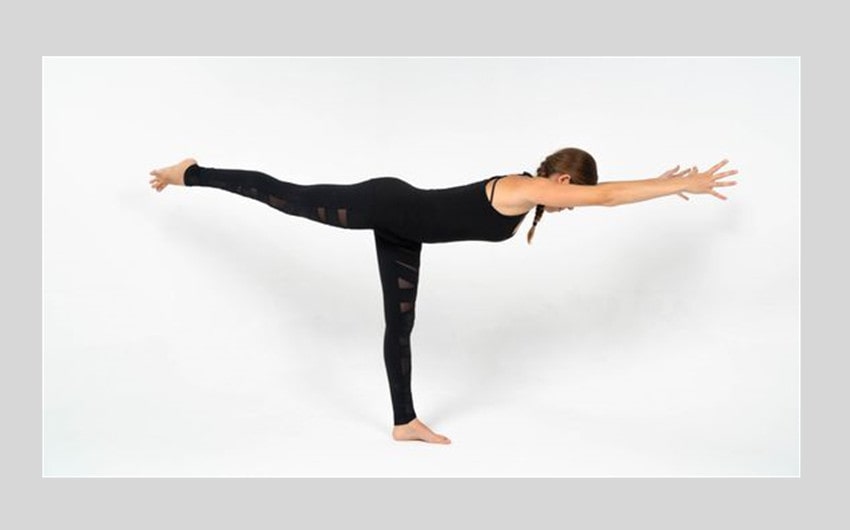
Image source: Pinterest
How to Do It: Begin in a standing position. Step one foot forward and shift your weight onto that leg. Hinge at the hips, lifting your back leg behind you while keeping it straight. Extend your arms forward or place them at your sides, creating a straight line from your fingertips to your extended foot. Keep your hips square and your standing leg strong. Focus on a point in front of you to help maintain balance. Hold for several breaths, then switch sides.
Benefits: Warrior III strengthens the legs, glutes, core, and back while improving balance and stability. It promotes full-body coordination and enhances mental focus, making it a powerful posture for both physical and mental endurance. This pose also stretches the hamstrings and improves posture by strengthening the muscles along the spine.
43. Utthita Parsvakonasana (Extended Side Angle Pose)
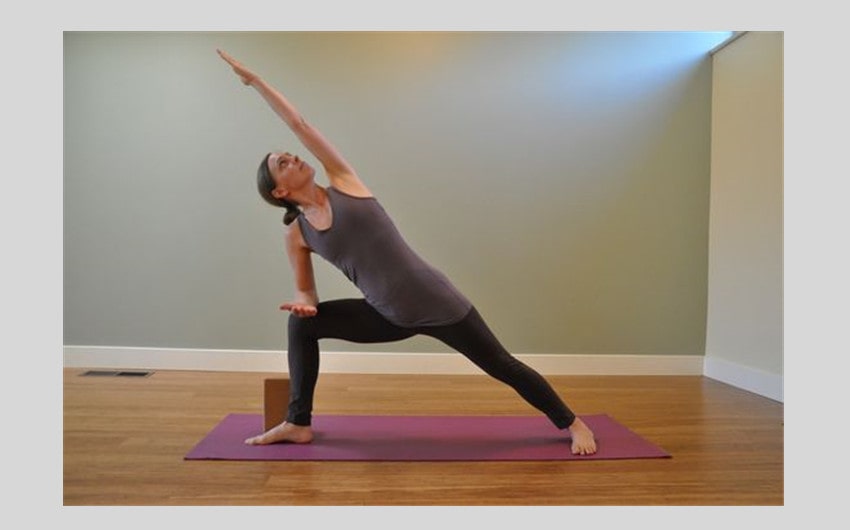
Image source: Pinterest
How to Do It: Start in a standing position with your feet wide apart. Turn your front foot forward and bend your knee until it’s directly over your ankle. Extend your back leg straight, pressing the outer edge of your back foot into the ground.
Bring your front elbow to rest on your knee or lower your hand to the floor outside your front foot. Reach your other arm up and over your head, creating a long line from your back foot to your fingertips. Gaze up toward your extended hand and hold for several breaths, then switch sides.
Benefits: Utthita Parsvakonasana stretches the hips, groin, and side body while strengthening the legs, core, and shoulders. This pose enhances flexibility in the hips and spine while also promoting balance and stability. It helps to open the chest and lungs, improving breathing capacity. Extended Side Angle Pose builds stamina and encourages a sense of openness and expansion in the body.
44. Parivrtta Utkatasana (Revolved Chair Pose)
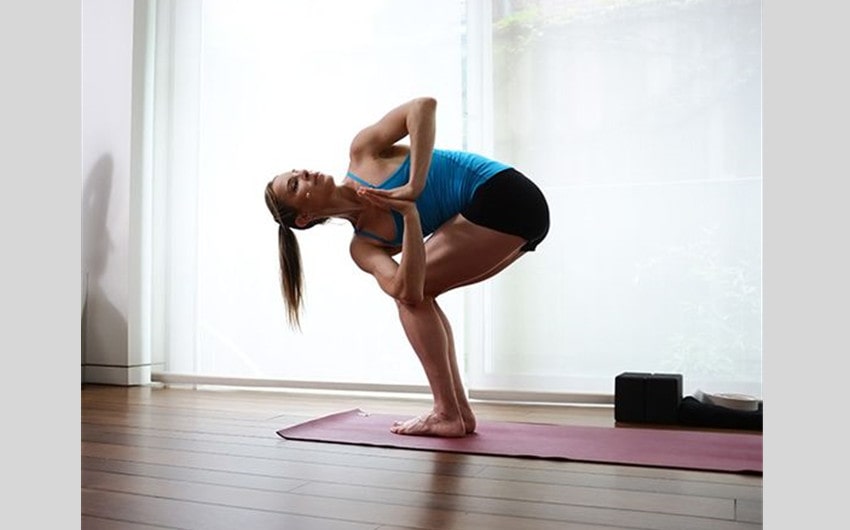
Image source: Pinterest
How to Do It: Begin in Utkatasana (Chair Pose) with your feet together and your knees bent. Bring your palms together at your chest in a prayer position. Inhale to lengthen your spine, and as you exhale, twist your torso to the right, bringing your left elbow to the outside of your right knee. Keep your hips square and your chest open. Press your hands firmly together to deepen the twist. Hold for several breaths, then return to the center and repeat on the other side.
Benefits: Parivrtta Utkatasana strengthens the legs, glutes, and core while improving balance and flexibility. The twisting motion stimulates digestion and detoxifies the internal organs. This pose helps improve spinal mobility and promotes better posture. It also enhances mental focus and concentration by challenging both balance and coordination.
45. Bhujapidasana (Shoulder-Pressing Pose)
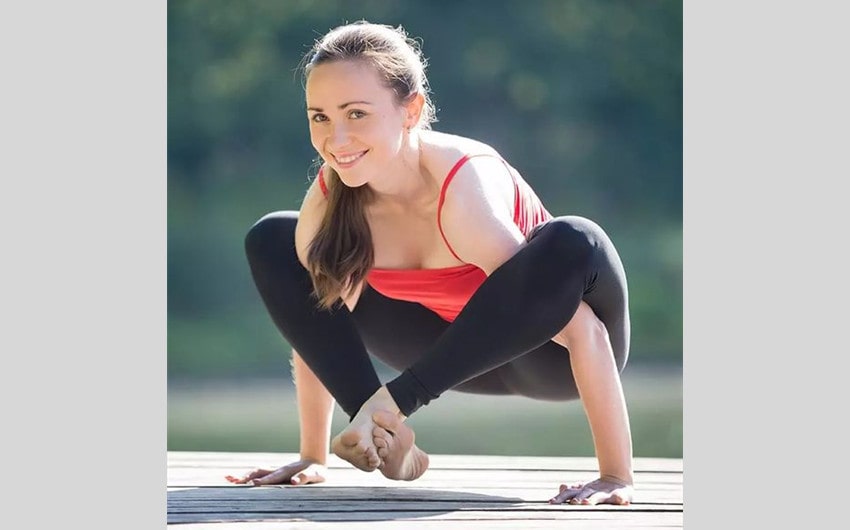
Image source: Pinterest
How to Do It: Begin in a squat position with your feet slightly wider than hip-width apart. Bend forward and place your hands on the ground behind your feet, shoulder-width apart. Lift your hips and slide your arms under your legs, resting your thighs on the backs of your upper arms. Shift your weight forward onto your hands as you lift your feet off the ground, crossing your ankles. Engage your core to balance on your hands, keeping your gaze forward.
Benefits: Bhujapidasana strengthens the arms, shoulders, wrists, and core while improving balance and coordination. This arm balance increases flexibility in the hips and groin and helps build upper body strength. The pose also enhances mental focus and concentration, as it requires deep body awareness and control. Practicing this pose regularly helps develop both physical and mental endurance.
46. Karnapidasana (Ear Pressure Pose)
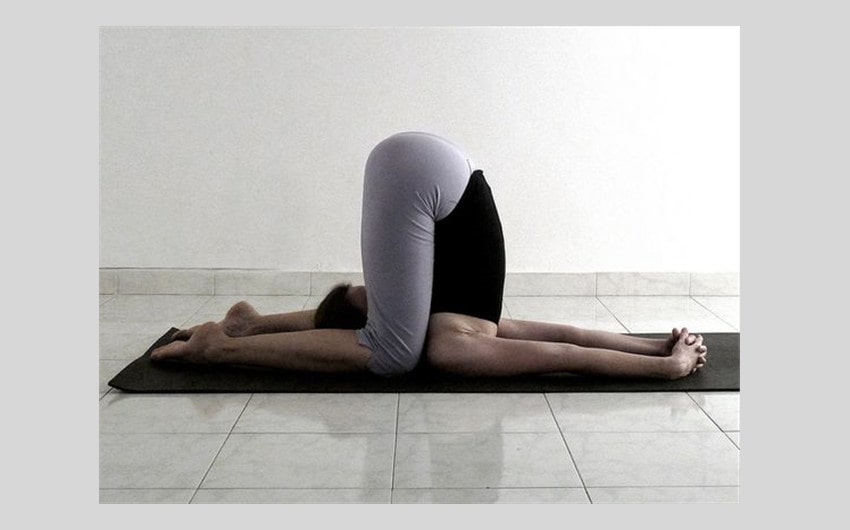
Image source: Pinterest
How to Do It: Begin by lying flat on your back with your arms resting by your sides. Lift your legs over your head and bring them into Halasana (Plow Pose), where your toes touch the floor behind your head. Once in Plow Pose, bend your knees and lower them toward your ears, pressing your knees gently against the sides of your head. Keep your arms extended along the floor or interlace your fingers behind your back. Hold for several breaths, focusing on the stretch and relaxation.
Benefits: Karnapidasana stretches the spine, shoulders, and neck while applying gentle pressure to the ears, which can have a calming effect on the mind. This pose promotes deep relaxation and helps reduce stress and anxiety. It also stimulates the thyroid gland, improving metabolism, and enhances circulation. The pose is excellent for relieving tension in the back and improving flexibility in the spine.
47. Astavakrasana (Eight-Angle Pose)
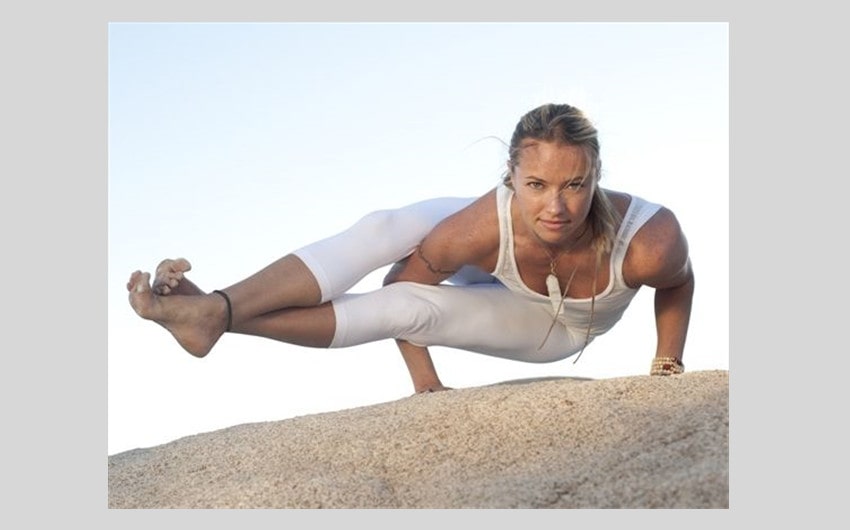
Image source: Pinterest
How to Do It: Start seated with your legs extended. Bend your right knee and bring your right foot over your left arm, hooking it behind your shoulder. Plant your hands on the floor beside your hips, shoulder-width apart. Press down into your palms and lift your hips off the floor, extending your legs to the left and crossing your ankles. Keep your legs straight and parallel to the ground while engaging your core. Hold for several breaths before lowering down, then switch sides.
Benefits: Astavakrasana strengthens the arms, wrists, shoulders, and core while improving balance and coordination. This advanced arm balance challenges both physical strength and flexibility, particularly in the hips and hamstrings. It helps build mental focus, resilience, and body awareness. Practicing this pose regularly improves upper body strength and increases flexibility in the legs and hips.
48. Salabhasana (Locust Pose)
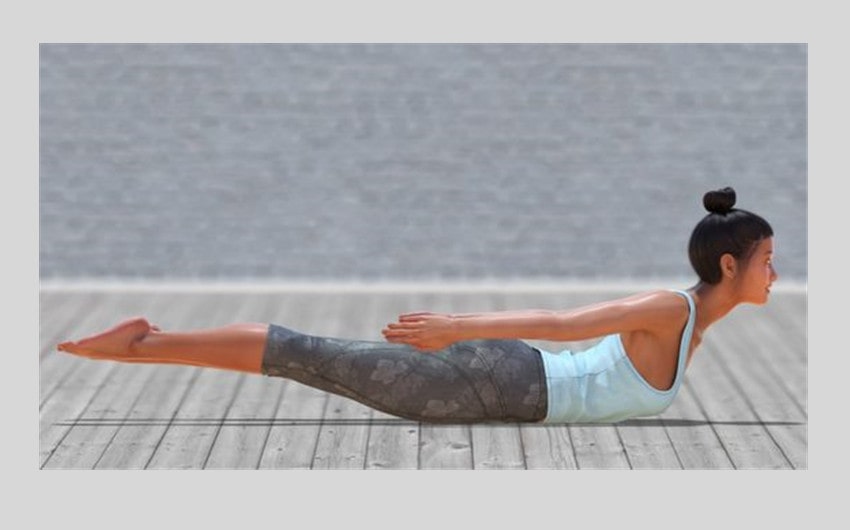
Image source: Pinterest
How to Do It: Lie face down on the mat with your arms alongside your body, palms facing down, and your forehead resting on the floor. On an inhale, lift your chest, arms, and legs off the floor, engaging your back muscles. Keep your arms straight and extend them backward, reaching through your fingertips. Press the tops of your feet into the floor to lift your legs higher, while keeping your gaze forward. Hold for several breaths, focusing on strengthening the back body.
Benefits: Salabhasana strengthens the entire back, including the spine, glutes, and hamstrings. It improves posture by strengthening the muscles that support the spine. This pose also opens the chest and improves lung capacity, making it beneficial for respiratory health. Additionally, Locust Pose increases flexibility in the shoulders and stimulates the abdominal organs, aiding in digestion.
49. Mayurasana (Peacock Pose)
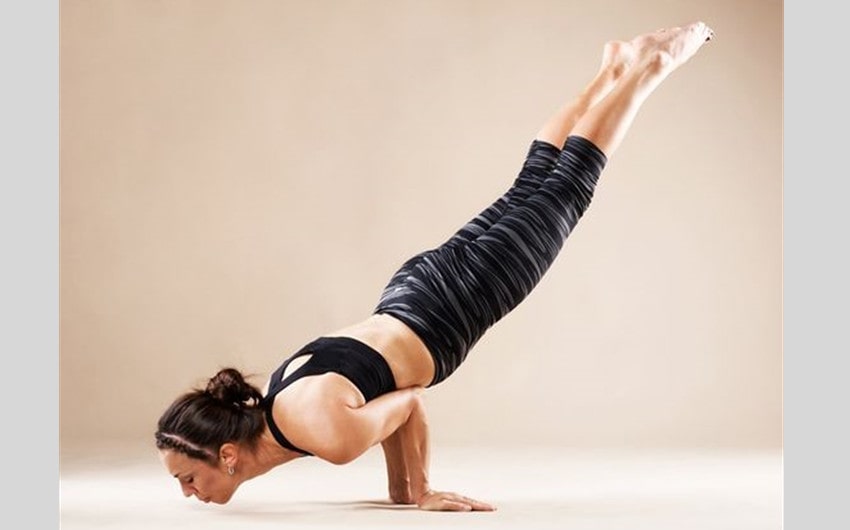
Image source: Pinterest
How to Do It: Start by kneeling on the floor. Place your hands on the mat in front of you, fingers pointing backward toward your feet. Bring your elbows close together, pressing them into your abdomen. Lean forward and lift your legs off the floor, extending them straight behind you. Balance your body on your hands, keeping your legs parallel to the floor. Engage your core and hold for several breaths, then gently lower back down.
Benefits: Mayurasana strengthens the arms, wrists, and core while improving balance and coordination. This pose stimulates the digestive system by applying pressure to the abdominal organs, helping to detoxify the body. It also builds endurance and resilience, both physically and mentally. Practicing Peacock Pose regularly improves upper body strength and enhances concentration.
50. Kapotasana (King Pigeon Pose)
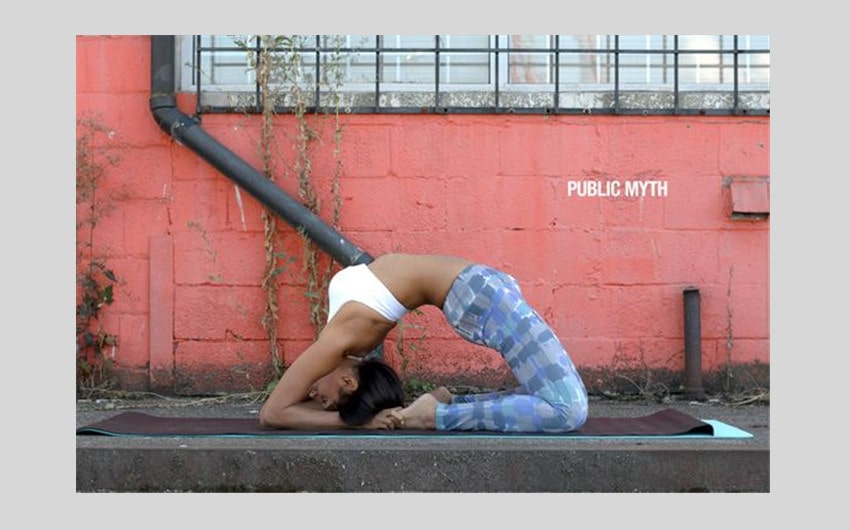
Image source: Pinterest
How to Do It: Begin in a kneeling position with your legs hip-width apart. Place your hands on your lower back, fingers pointing downward. As you inhale, lift your chest and begin to arch your back, pressing your hips forward. Reach your hands back to grasp your heels, keeping your chest lifted and your head tilted slightly back. If you’re comfortable, lower your head to the floor and place your forearms on the mat. Hold for several breaths, focusing on deepening the backbend.
Benefits: Kapotasana is a deep backbend that stretches the chest, abdomen, and thighs while strengthening the back muscles. It opens the heart and shoulders, improving flexibility and promoting better posture. This pose also stimulates the lungs and respiratory system, encouraging deep breathing. King Pigeon Pose helps to release tension in the hips and lower back and increases mental focus and resilience.
51. Sirsasana II (Tripod Headstand)
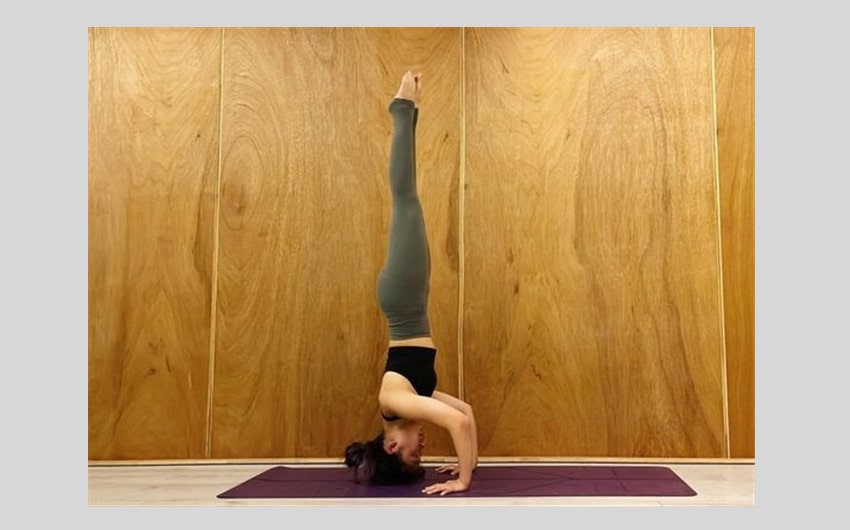
Image source: Pinterest
How to Do It: Start in a kneeling position. Place your hands shoulder-width apart on the mat and bring the crown of your head to the ground, forming a triangle with your head and hands. Press your palms firmly into the floor and engage your arms. Lift your hips up, walking your feet closer toward your head. Slowly lift your legs off the ground, bringing your knees to your chest. Then, extend your legs straight up toward the ceiling, keeping your body aligned and balanced. Hold for several breaths before slowly lowering down.
Benefits: Sirsasana II strengthens the arms, shoulders, and core while improving balance and stability. This pose stimulates blood flow to the brain, improving focus, memory, and concentration. It also helps calm the mind, reducing stress and anxiety. Regular practice of Tripod Headstand can enhance body awareness, build confidence, and improve overall posture and body control.
52. Dhanurasana (Bow Pose)
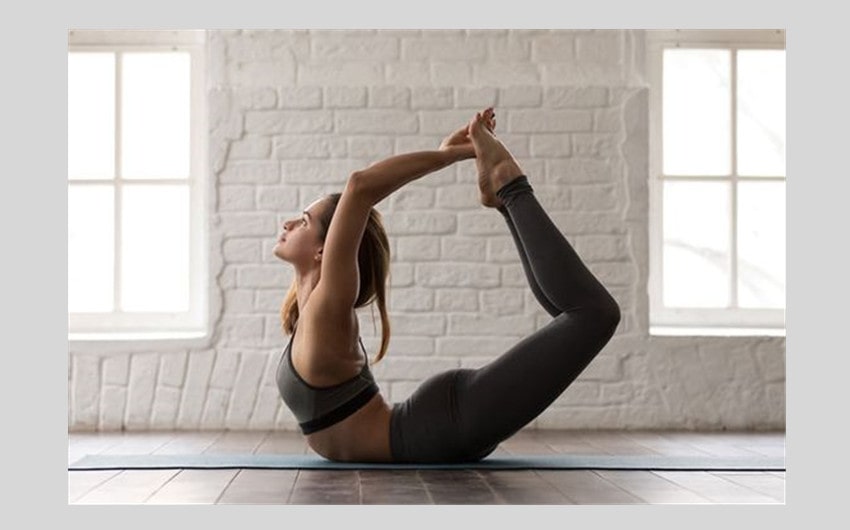
Image source: Pinterest
How to Do It: Begin lying on your stomach with your arms at your sides. Bend your knees and bring your heels toward your glutes. Reach back with both hands and grab your ankles. Inhale as you lift your chest and thighs off the ground, pulling your heels up and back, creating a bow shape with your body. Keep your gaze forward and hold the pose for several breaths, focusing on deepening the stretch in your chest and legs. Exhale as you gently lower back down.
Benefits: Dhanurasana strengthens the back, glutes, and legs while stretching the chest, shoulders, and thighs. This pose improves posture and flexibility in the spine. It opens the chest, helping to enhance lung capacity and breathing. Bow Pose stimulates the digestive organs, improving digestion and relieving constipation. It also energizes the body and mind, promoting mental focus and clarity.
53. Hanumanasana (Monkey Pose/Splits)
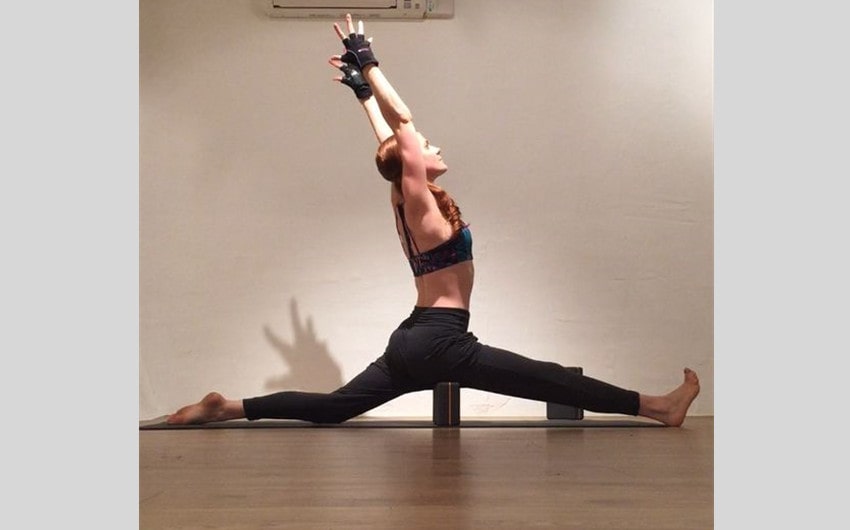
Image source: Pinterest
How to Do It: Start in a low lunge with your right foot forward and your left knee on the mat. Slowly slide your right foot forward and your left foot backward, lowering your hips toward the floor. Extend your legs as much as your flexibility allows, ensuring both hips are square to the front. Keep your hands on the floor or place them on blocks for support. Once stable, bring your arms overhead for a deeper stretch. Hold for several breaths, then switch sides.
Benefits: Hanumanasana stretches the hamstrings, quadriceps, and hip flexors, promoting flexibility in the legs and hips. This deep stretch helps to open the groin and improve range of motion in the lower body. It strengthens the legs and improves balance and concentration. Monkey Pose also enhances mental resilience, requiring patience and focus to develop flexibility over time.
54. Pincha Mayurasana (Forearm Stand)
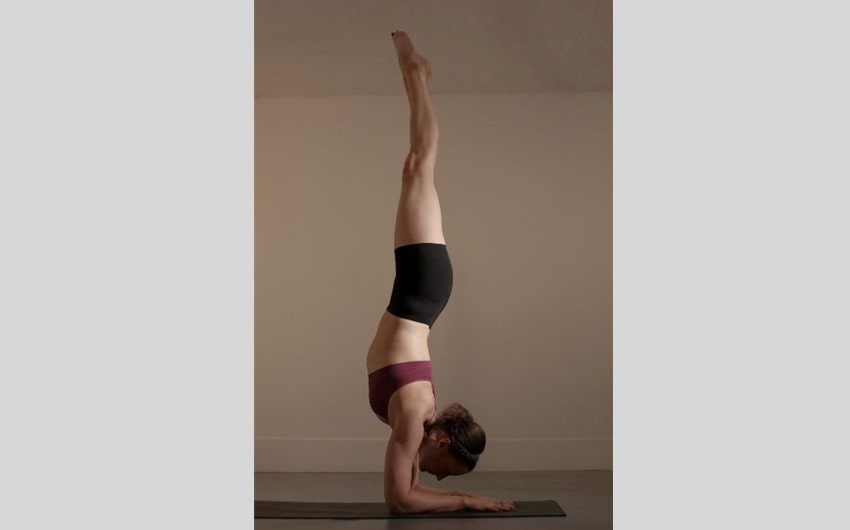
Image source: Pinterest
How to Do It: Begin in a dolphin pose with your forearms on the ground, shoulder-width apart, and your legs extended behind you. Press firmly into your forearms and engage your shoulders. Walk your feet toward your arms, raising your hips. Shift your weight forward and kick one leg up into the air, followed by the other, coming into a forearm stand. Keep your core engaged and your body aligned, with your legs extended upward. Hold for several breaths, then carefully lower back down.
Benefits: Pincha Mayurasana strengthens the shoulders, arms, and core while improving balance and body control. This pose enhances flexibility in the shoulders and builds stability in the upper body. Forearm Stand increases blood flow to the brain, improving focus, mental clarity, and reducing stress. It also boosts confidence and body awareness, as it requires precision and balance.
55. Vasisthasana (Side Plank Pose)
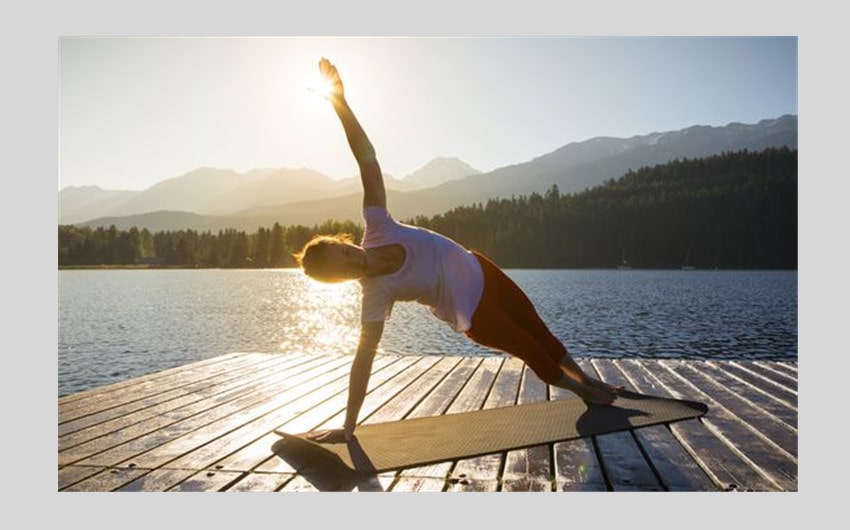
Image source: Pinterest
How to Do It: Start in a high plank position with your wrists directly under your shoulders. Shift your weight onto your right hand and the outer edge of your right foot. Stack your left foot on top of your right and extend your left arm toward the ceiling. Engage your core and keep your body in a straight line. Hold the pose for several breaths, focusing on balance and stability. Switch sides by returning to plank and repeating on the opposite side.
Benefits: Vasisthasana strengthens the arms, wrists, shoulders, and core while improving balance and coordination. It stretches the sides of the body and enhances flexibility in the hips and legs. This pose builds endurance, stability, and body awareness, making it an excellent posture for developing core strength. Side Plank Pose also promotes mental focus and concentration, requiring steady balance and control.

